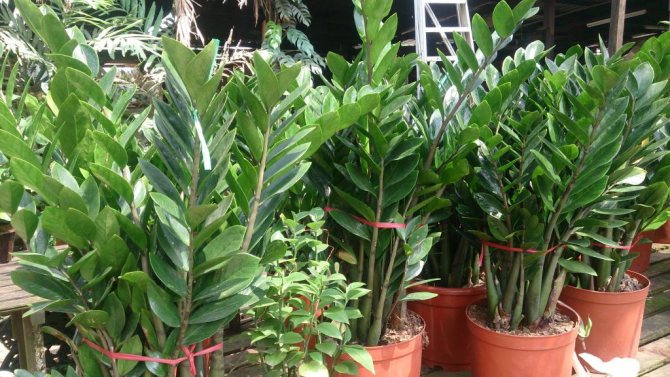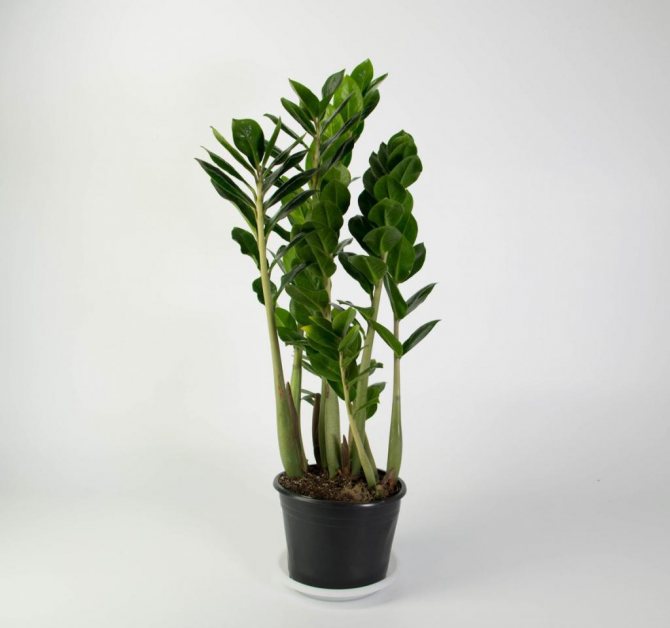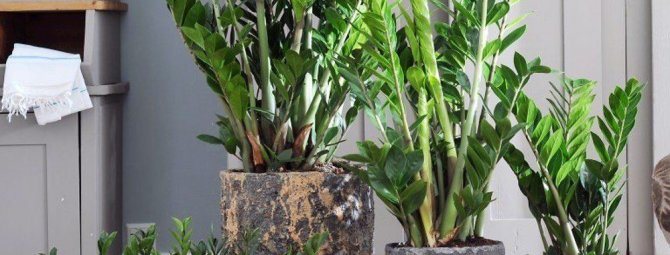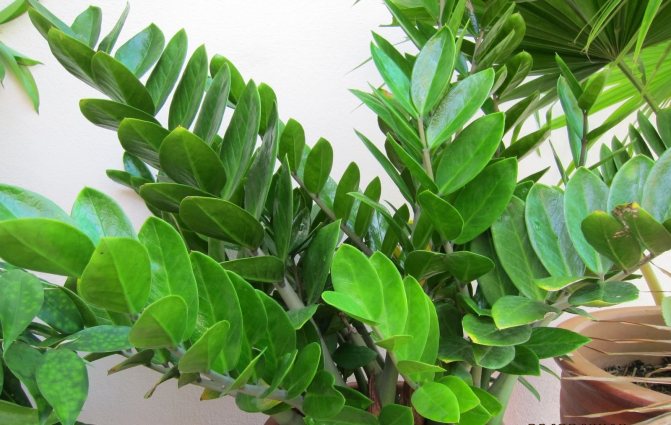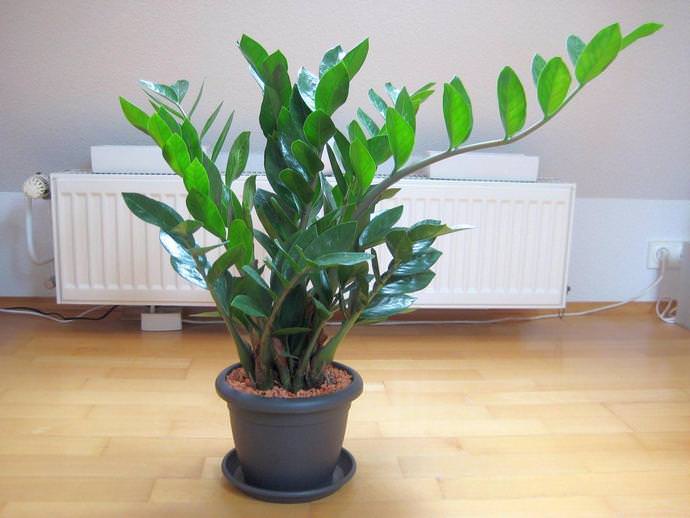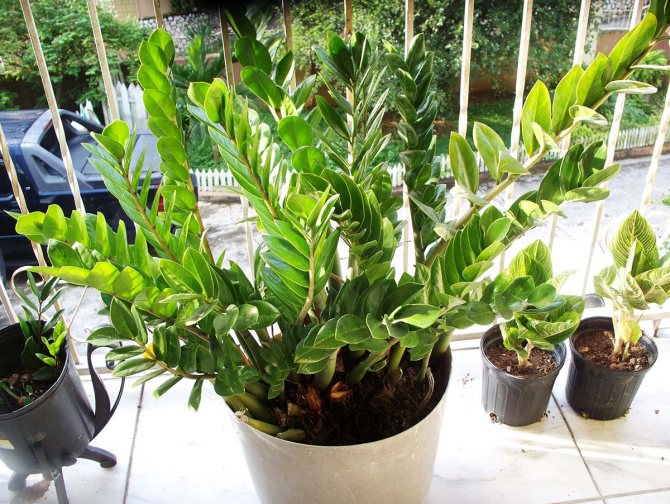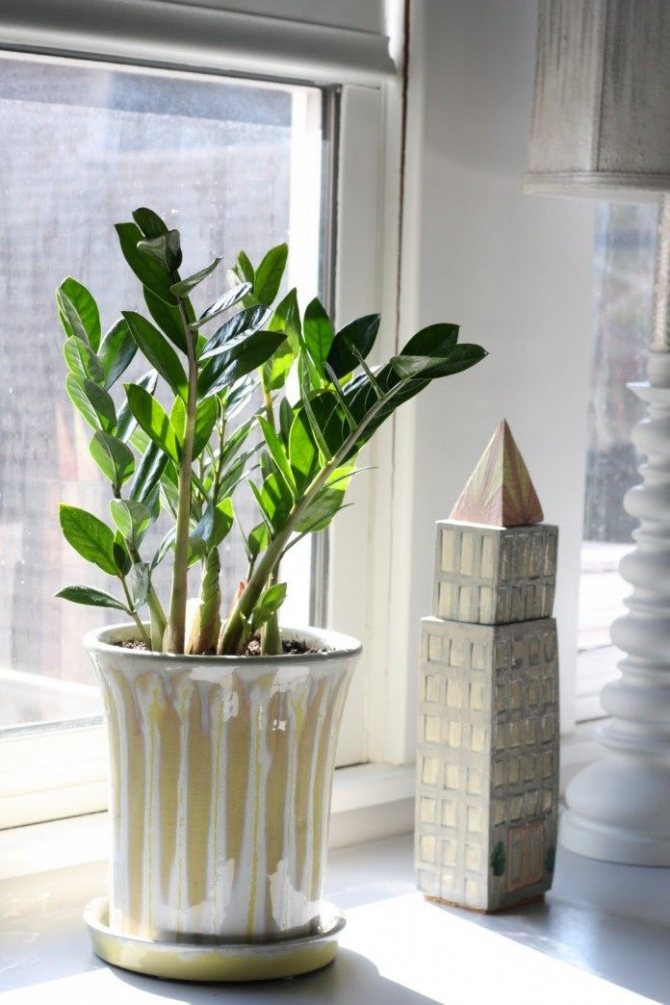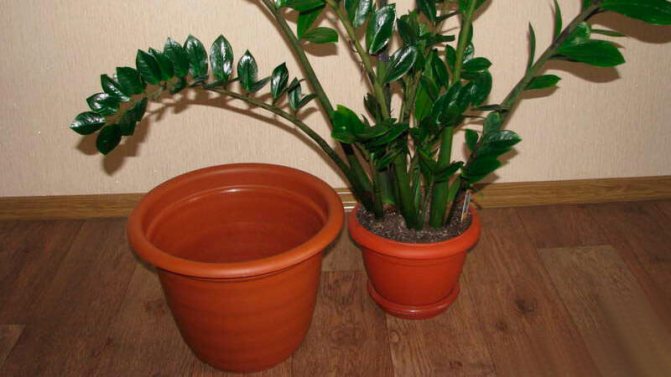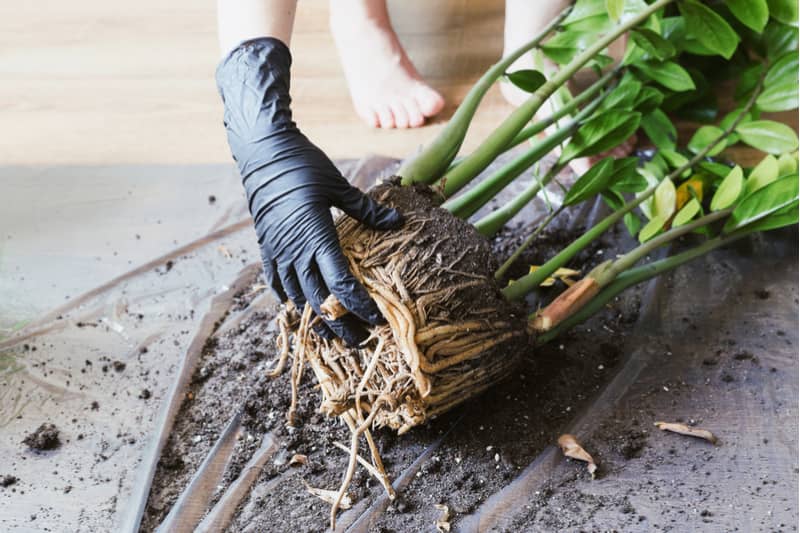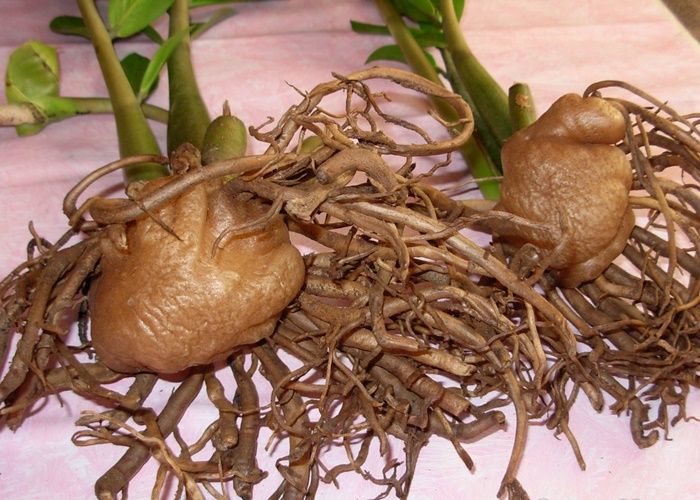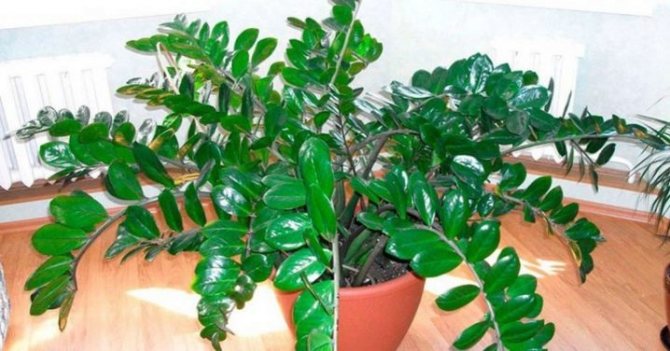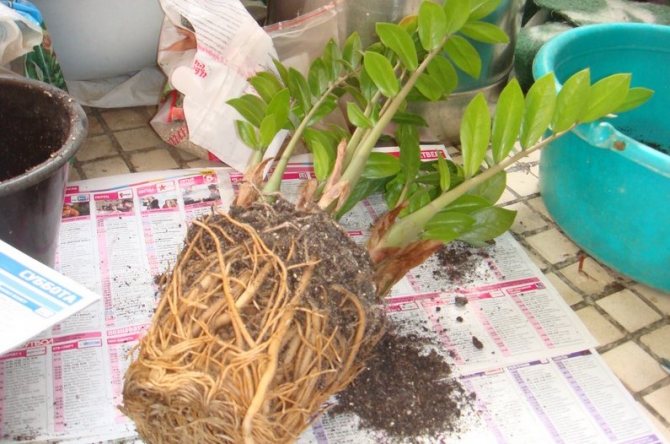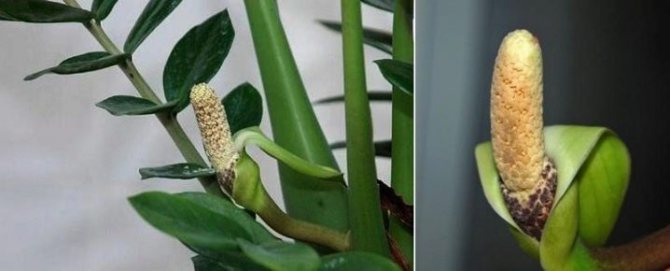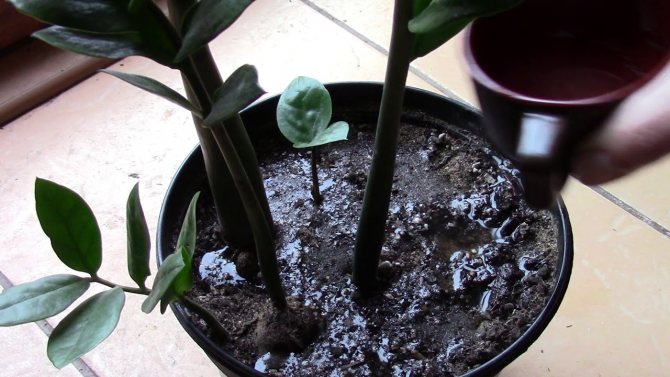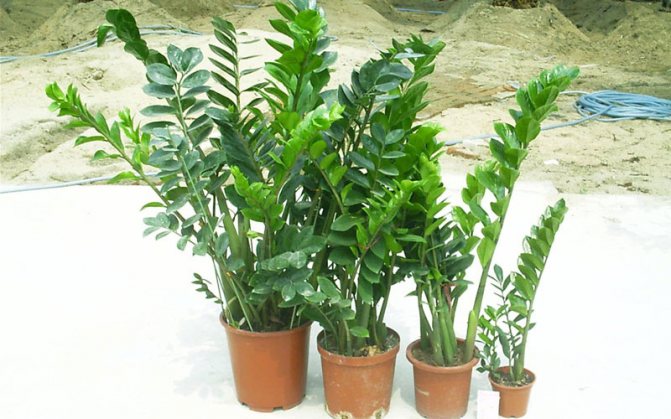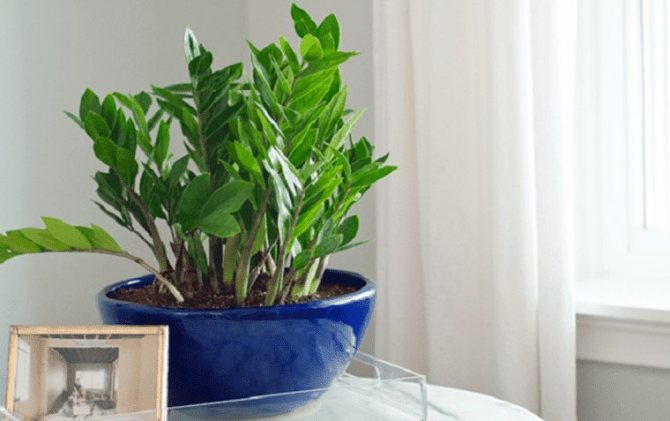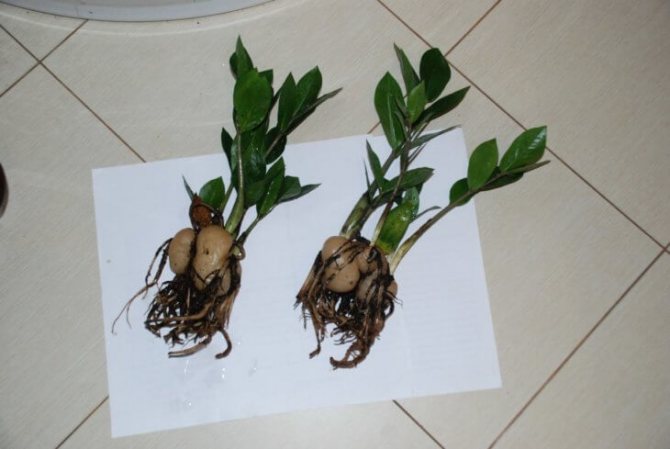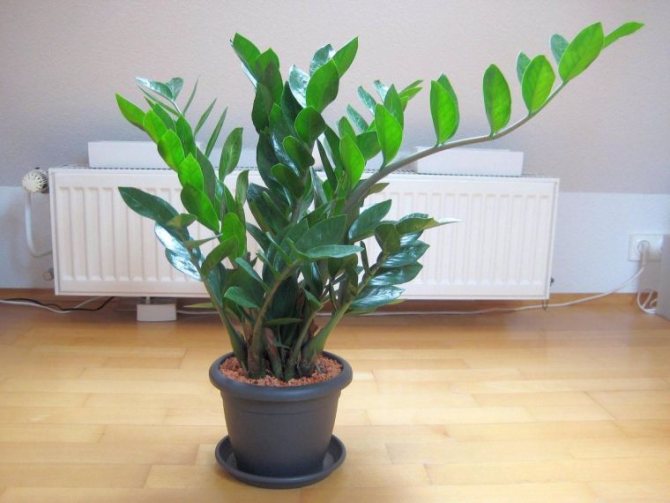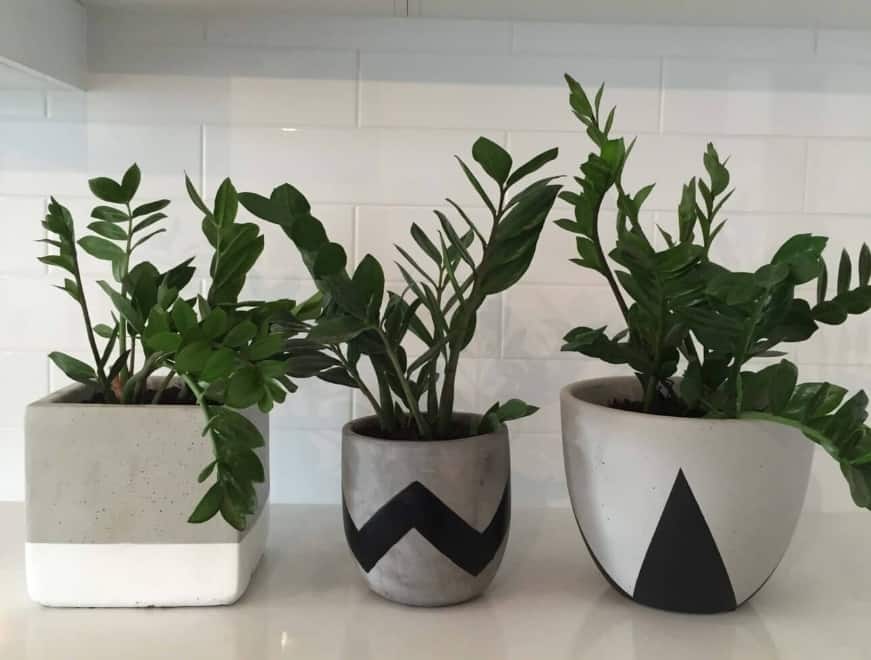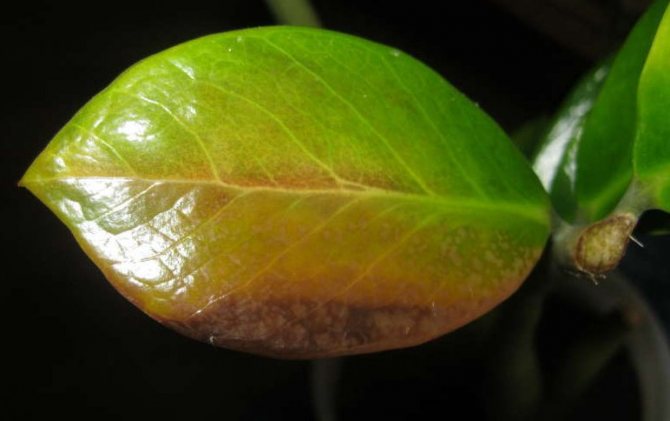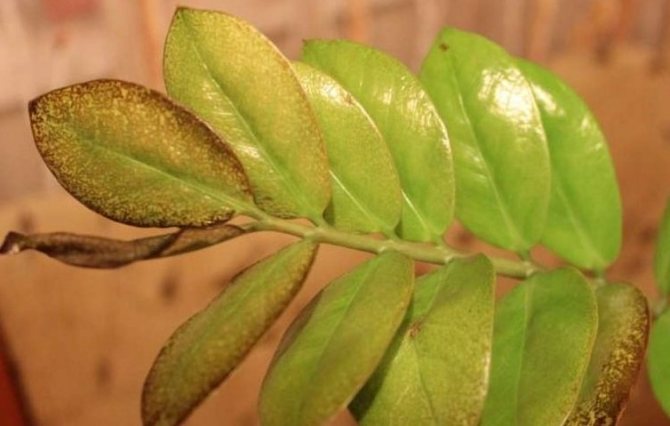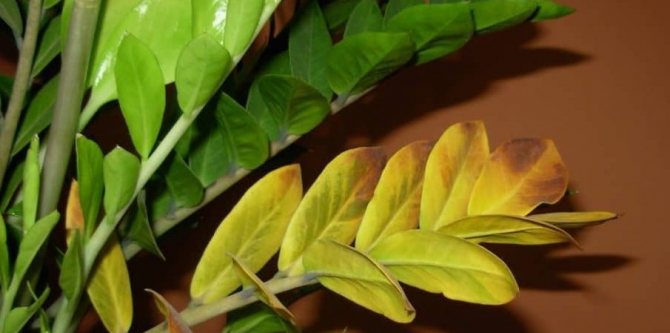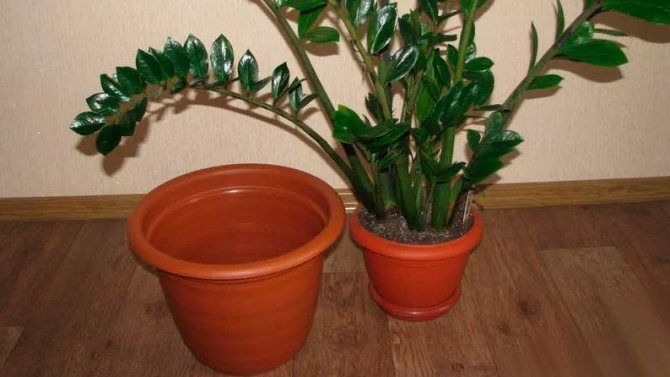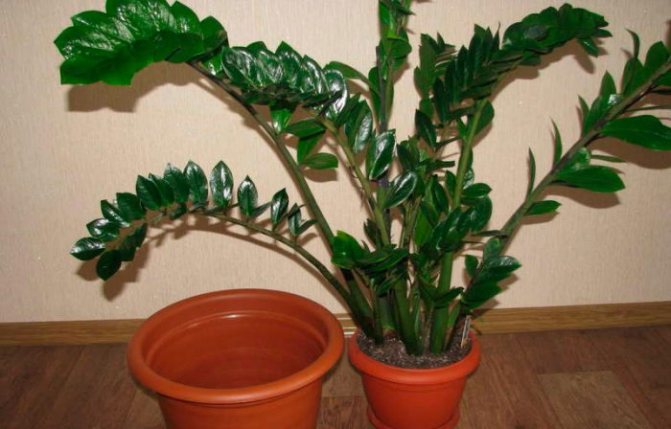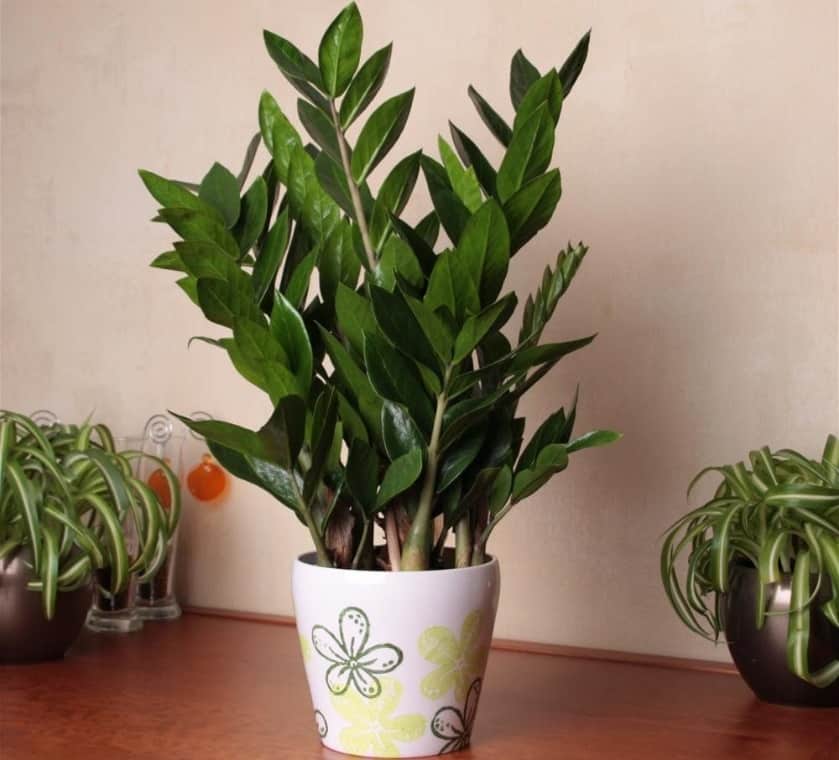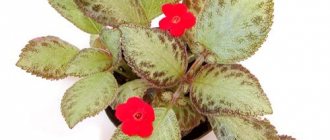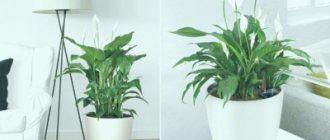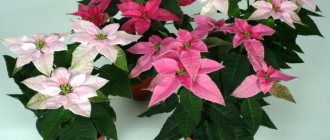Zamioculcas is a representative of large herbaceous plants of East Africa. A distinctive feature is the beautiful shiny foliage and original flowers that resemble greenish cobs in shape.
Despite its exotic origin, the plant is not capricious, it easily adapts to living conditions. Of course, novice growers will need to familiarize themselves with the rules of care, as well as find out in what soil to plant zamiokulkas - for a plant this moment is very important.
Features of home content
For all its presentability and luxurious appearance, the zamiokulkas, or dollar tree, is very easy to care for. It is not for nothing that it is called a plant for lazy housewives.
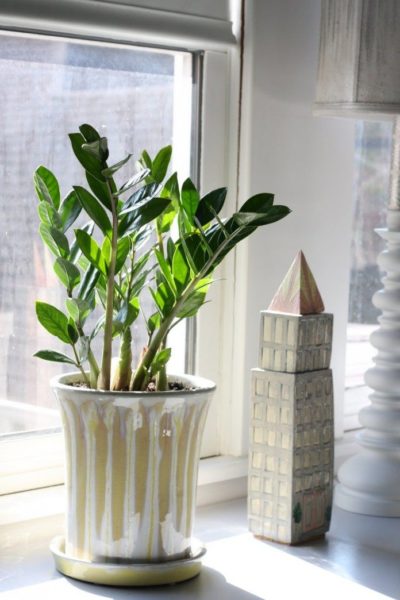
Zamioculcas is very popular in indoor floriculture
Humidity
Perfectly adapting to the conditions of our apartments, Zamiokulkas easily endures even the heating season. And if the handsome man is completely indifferent to spraying, then wiping the leaves with a damp cloth or infrequent bathing in the shower will be accepted with gratitude. Such procedures will free from accumulated dust and help the plant to express itself in all its glory.
Lighting
The plant is also not particularly demanding for lighting, it feels great in bright (but you still need to shade slightly from the direct sun) and diffused light. In summer it willingly grows in the fresh air. But in winter, it is better to put the zamioculcas closer to the window, so that in a short light period the plant does not lose its rich color of leaves.
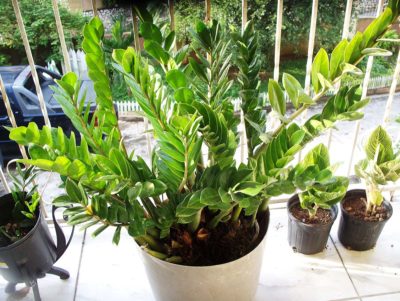

Summer Zamioculcas likes to spend outdoors
Temperature
A native of the hot African continent, he loves warmth. Therefore, when the thermometer creeps to + 30 ° C, the zamioculcas feels quite normal. Still, a comfortable temperature in summer should be + 20 ... + 25 ° С. In winter, it is preferable to keep the plant in cooler conditions, at + 16 ... + 20 ° С. The critical temperature in winter is not lower than + 12 ° С.
Watering
Watering zamioculcas should be done carefully, because due to the ability to accumulate water in the roots, the plant often suffers from waterlogging of the soil. In the summer, before the next watering, you need to wait until the soil in the pot is half dry. In winter, when kept in a cool room, watering is reduced to a minimum, producing regular moisture after almost complete drying of the substrate, which can be determined by the color of the soil - dried soil of a lighter shade.
Top dressing
During the growing season, from March to September, zamiokulkas is fertilized once every 2 weeks. Top dressing must be chosen carefully. Compositions containing nitrogen can harm the root system, as well as a high concentration of the solution. For zamioculcas, it is better to use fertilizers for succulents and cacti, diluting the dose in more water than indicated.
Top dressing is applied only to moist soil.
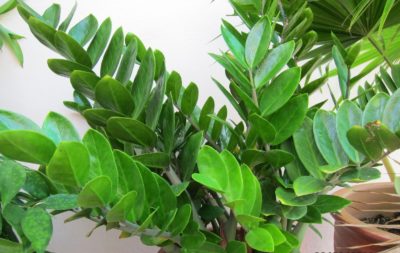

Zamioculcas should be fed carefully, in reduced doses.
Transplant features
In the event that the root system needs to be examined and freed from excess soil, take a basin of water and soak the roots there. The peat composition will get wet and lag behind the roots. Then you can gently wash them with clean water.
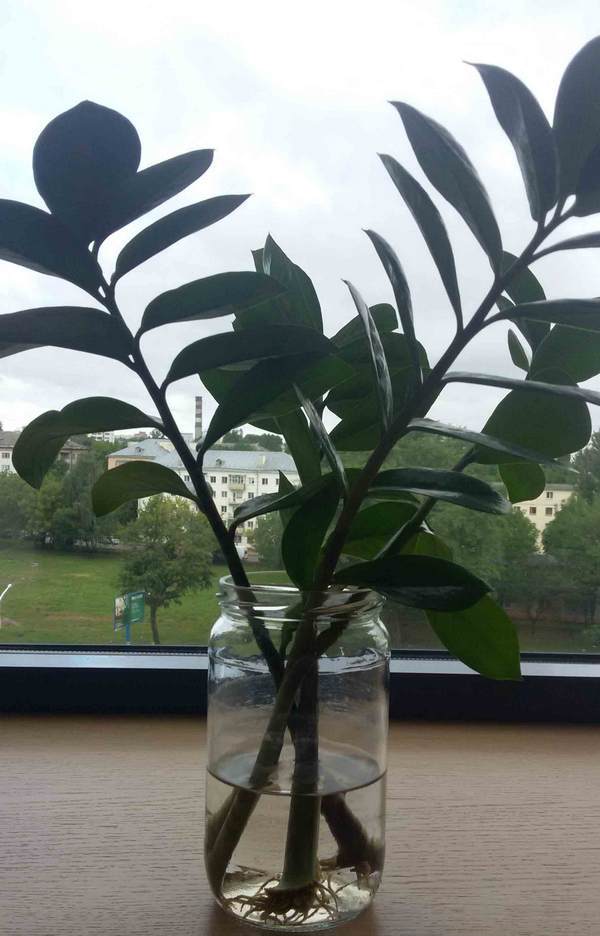

Plant roots can be soaked in water to free them from soil
If you find injured areas of the root system, carefully remove them with a well-sharpened knife. Sprinkle the cut sites with crushed activated carbon and leave these areas to dry for a day.
On a note! After planting zamioculcas, do not water it for a week so that the root system can recover.


Damaged root parts should be removed
Boarding and transfer rules
A transplant for any plant is a very crucial moment. Finding the right substrate and capacity is half the battle. You also need to skillfully cope with the process itself. However, do not be alarmed, there is nothing difficult in a transplant if you act on time and in accordance with all the rules.
We select the soil and the pot
When choosing a soil for planting or transplanting zamiokulkas, one should take into account its ability to accumulate water by roots and the natural growing conditions. Therefore, the soil for the plant must meet the following requirements:
- Be very loose, so that after watering the water can seep through the soil unhindered and not overloaded with nutrients.
- Have good air permeability so that the roots do not lack oxygen.
- Have neutral acidity.
When purchasing soil from a store, you need to choose soils designed for succulents. But even in them it is advisable to add brick chips, vermiculite or drainage of the finest fraction as a baking powder. Still, take the time and effort to prepare a suitable substrate yourself. Moreover, you do not need to go to Africa for its components, they can be easily found in a flower shop. You will need to mix in equal proportions:
- sod land;
- leafy ground;
- peat;
- coarse sand.
A handful of charcoal will be a good addition to the composition: it absorbs excess moisture and prevents the development of pathogenic fungi. Heavy earth containing clay is strictly prohibited. The water in it will stagnate, and the roots will lack oxygen. The result will be deplorable - the zamioculcas will die.
Be sure to disinfect the soil. You can do this in the oven or in the freezer. High and low temperatures are equally destructive for pests and pathogenic flora.
Choosing a pot is a task no less important than preparing the soil. Zamioculcas is a rather big plant, and its root system is capable of greatly increasing in size. Plastic containers are only suitable for young plants. For adult specimens, you need to choose stable ceramic pots. Drainage holes are required!
The pot must be high so that the drainage layer can take up at least ¼ of the total volume. In shape, it is better to choose vases that are narrowed downwards, but with a wide top, so that when transplanting it is more convenient to extract the plant. The size of the new container should differ from the old one by several centimeters. Don't think too big a pot is good. Only the underground part will develop in a large volume, and the green mass will only have to patiently wait for the roots to master the space.


Pick a high pot for zamiokulkas, with a wide top
When is it better to transplant
The best time for transplanting, of course, is spring. But if you missed the moment, then you can postpone the process to the beginning of summer. A slow-growing flower is rarely transplanted - once every 3-4 years, when the roots become cramped and the growth of the flower stops. Young plants need annual handling.
If you purchased zamiokulkas in a store in the fall, then give it a couple of weeks to acclimatize, and then transplant it into a new container. This is done for 2 reasons:
- As a rule, the plant is already cramped in the transport pots.This can be determined by the deformation of the plastic container.
- The soil in which the zamioculcas is purchased is not suitable for the plant. It is based on a lot of peat, which retains moisture, and this is useless for the plant.
An autumn transplant will not cause any discomfort to Zamiokulkas.
Step-by-step instructions for transplanting
- We fill a new pot with a quarter of the volume with drainage. Pour a little of the prepared substrate on top.
- We begin to carefully remove the zamioculcas from the old pot. Sometimes it is very difficult to do this because of the overgrown root system. To facilitate the task, you can wrinkle the plastic container with your hands. Then lay the pot on its side, hold the bottom with one hand, and with the other try to grab all the leaves closer to the soil and pull gently. If the process went easily, good, but if the plant sits tightly in the pot, then there is nothing left but to cut it.
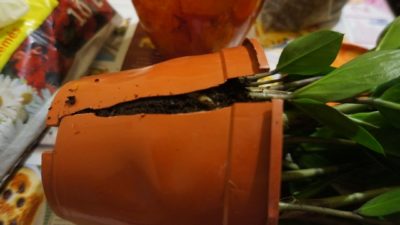

If the roots are overgrown, the pot is best cut
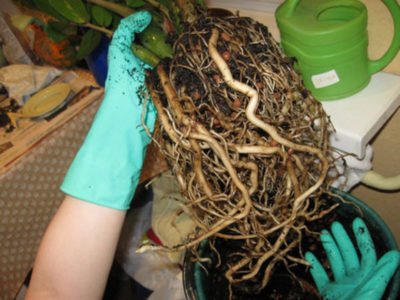

Zamiokulkas is transplanted by the transshipment method
What is necessary?
Before transplanting zamiokulkas, it is important not only to give it some time to get used to the new climatic conditions (wait until it grows green mass), but also to start choosing a suitable container and soil. The planting pot must be sized and matched. The rhizomes of plants develop rapidly, and they will be able to "break" a pot made of thin and fragile plastic with their strength. This also applies to beautiful pots made of glass or decorative ceramics.
Therefore, it is best to give preference to unglazed clay containers, since they have increased strength, and the porous surface of the clay contributes to the rapid intake and release of moisture.
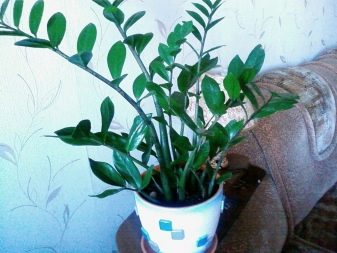

As for the size, it is advisable to purchase a larger pot for transplanting a flower. Its diameter is selected in accordance with the dimensions of the planted tubers. In addition, it should be borne in mind that the rhizomes of the plant are accustomed in natural nature to extract moisture and nutrients not only in easily accessible places, but also at depth. If the "money tree" is initially planted in a small pot, then problems may arise during subsequent transplants.
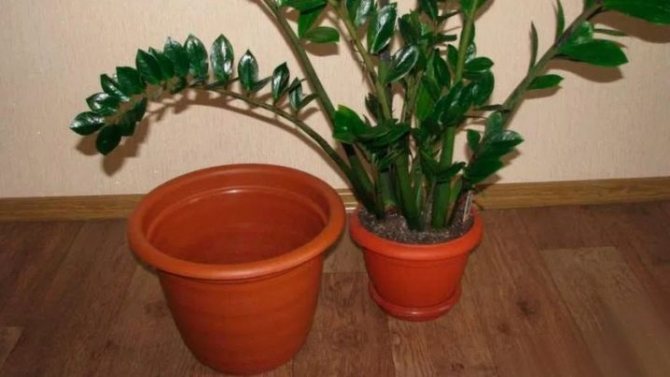

It is difficult to remove the roots that have grown at a depth, so it is important to foresee this moment in advance, and fill the container 1/4 with large expanded clay. If you transplant a flower into a huge pot, then its growth and flowering may slow down, but only until the rhizomes cover most of the soil. An important role is played by the shape of the container into which it is planned to transplant the plant.
Low and wide pots are best for this type of decorative flower.
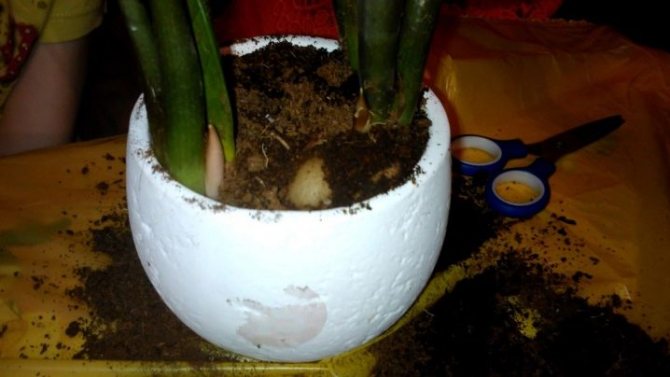

In addition to the pot, good soil should be picked up before planting zamiokulkas. The "dollar tree" usually grows in the wild on sandy and rocky soils with an admixture of humus. At home, it is recommended for him to independently prepare an earthen mixture consisting of garden soil, peat and humus. In such a soil, the flower will be able to quickly build up its aerial part and receive the required amount of moisture and minerals.
However, it is necessary to correctly observe the proportions of the components during the preparation of the earthen mixture, otherwise it will turn out to be saturated, prone to moisture accumulation, which will certainly lead to decay of the roots.
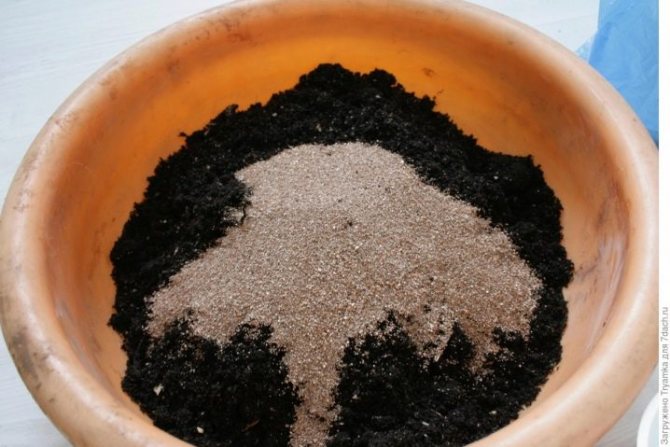

The soil for transplanting should be not only nutritious, but also moisture-permeable, with a loose structure. If the gardener does not have experience in preparing the planting substrate on his own, then it is best to purchase it ready-made. For this, the stores sell soil designed for this type of plant.In addition, perlite, washed medium-grained river sand, expanded clay or granite chips will have to be added to the purchased universal mixture by 1/3 of its total volume, fragments of charcoal are also suitable.
Table: Possible transplant problems and how to fix them
| Problem | Cause | Elimination |
| Zamiokulkas leaves after transplantation lost turgor | There can be three reasons:
|
|
| Branch broke during transplant | Zamiokulkas has very juicy leaves, so you need to be careful when working with it. | It's okay, the wound on a large plant can be sprinkled with crushed coal. A broken branch can be rooted. |
| Zamioculcas does not grow after transplantation | The pot is too big. | Until the roots take over the entire space, the leaves will not grow. When transplanting, you need to choose a container that is no more than 4 cm larger than the previous one. |
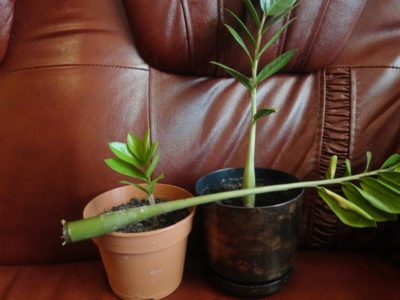

If a zamiokulkas leaf breaks during transplantation, it does not matter, it can be rooted
As you already understood, the transplant is not as scary as it seems at first. The main thing is to choose the right soil, pot and complete the work in stages. And in gratitude for the work done, Zamiokulkas will certainly thank you with luxurious leaves, and possibly flowering.
Zamioculcas (Zamioculcas) is a large herbaceous plant belonging to the aroid.
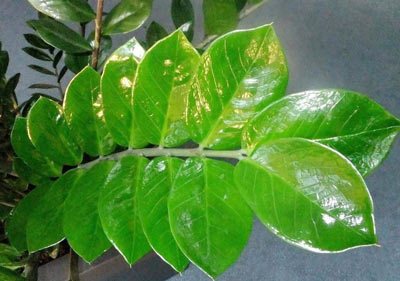

Sometimes it is also called the dollar tree. East Africa is considered his homeland.
It is characterized by very beautiful foliage and specific inflorescences, more like cobscovered with a greenish veil.
Despite its exoticism, this flower is not picky, has great endurance and, if properly maintained, grows well in the conditions of ordinary city apartments.
But in order for zamioculcas to develop correctly, you need to know the rules for caring for it. One of them is a transplant.
How to transplant?
After the zamiokulkas was purchased, acclimatized in new conditions for him, and all the work on preparing for the transplant is completed, you can safely proceed to the direct process of planting a flower in another pot.
Experienced experts advise transshipment of the plant, since this is the easiest way of transplanting, in which the risk of damage to the roots is eliminated, and the flower after it continues its active growth without loss.
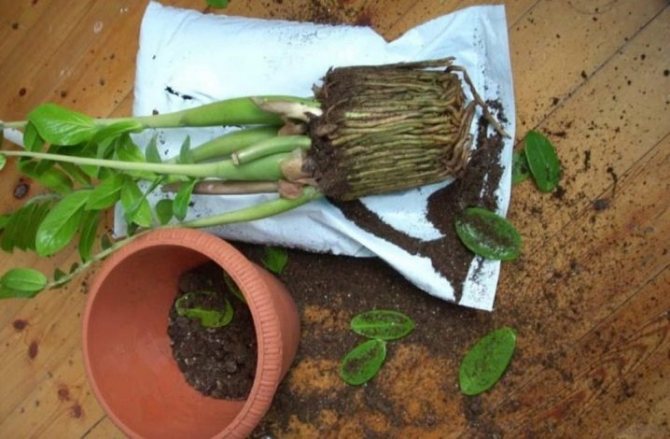

Before transplanting a large bush at a "mature" age, you should thoroughly clean the rhizome from the remnants of the old soil. If the "dollar tree" consists of tubers with stems, then it should be divided into several independent seedlings, each placed in a separate pot.
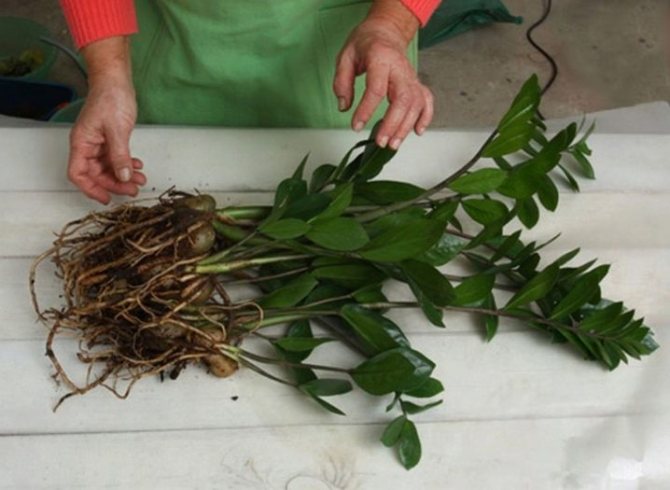

The process of transplanting a flower should take place step by step and correctly. If this is done by a florist for the first time, then a simple instruction will come to the rescue.
- First of all, a seat is being prepared. A small layer of expanded clay is poured into the bottom of the previously selected container. A moist layer of earth should be laid on top, which would completely cover the drainage, while there should also be room for free placement of roots.
- After that, the seedling is placed with roots in the soil and covered so that the upper parts of the roots remain slightly on the surface. Then the soil is carefully compacted, which will further contribute to the conservation of moisture.
- Upon completion, the transplanted flower is placed in a place protected from the penetration of bright rays of the sun and watched for its engraftment. If everything was done correctly, then after a few weeks the zamioculcas will begin to be covered with new foliage, and will delight with its decorative appearance.
Zamioculcas (Zamioculcas) is a large herbaceous plant belonging to the aroid.
Sometimes it is also called the dollar tree. East Africa is considered his homeland.
It is characterized by very beautiful foliage and specific inflorescences, more like cobscovered with a greenish veil.
Despite its exoticism, this flower is not picky, has great endurance and, if properly maintained, grows well in the conditions of ordinary city apartments.
But in order for zamioculcas to develop correctly, you need to know the rules for caring for it. One of them is a transplant.
Zamokulkas: change after purchase
Zamioculcas cannot be transplanted immediately after purchase. Having brought a flower home, he, first of all, is recommended to arrange a quarantine. To do this, it needs to be placed in a room where there are no other colors for several weeks. At this time, it is necessary to water as needed and monitor the state of the new pet.
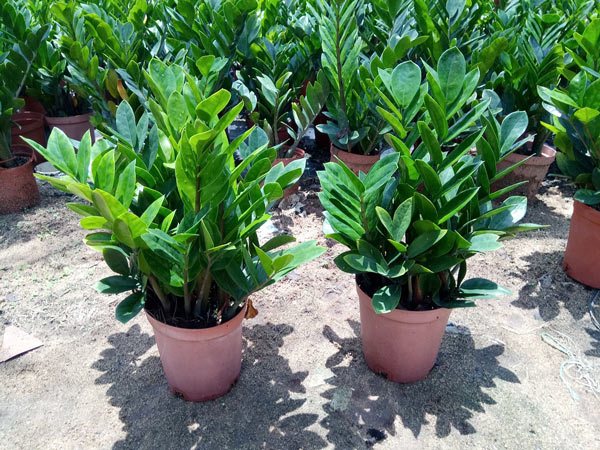

When buying plants in the store, you can often overlook the presence of diseases and pests... If they are found during quarantine, an appropriate treatment is urgently needed.
After the expiry of the quarantine period, the zamiokulkas must be transplanted. The fact is that the soil in which the plants are in the store is transportable. It does not contain those substances that are required for the proper development and active growth of flowers.
At the same time, during transportation and maintenance at points of sale, watering is carried out by special means. Such soil absorbs water poorly, which can provoke the development of various diseases of the root system. Therefore, when transplanting, this substrate must be replaced with a nutritious soil mixture.
It is advisable to transplant zamiokulkas in the spring (read about the ideal time for transplanting indoor plants here). But, if the flower was bought at another time, you should not adhere to this rule, you need to transplant it no later than 3 weeks after purchase.
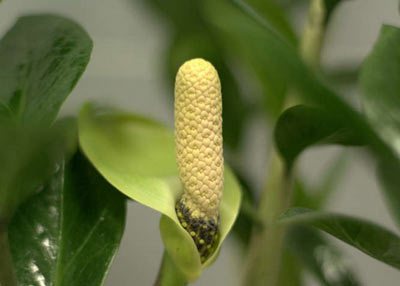

If the zamioculcas blooms, then the buds are likely to fall off.
There is nothing wrong with that, on the contrary, the plant will have more strength to acclimatize.
The next flowering, as a rule, with proper care, occurs in the prescribed period.
How to transplant a dollar tree after purchase (video)
It is important to remember that when transplanting an adult and already flowering acquired plant, shedding of flowers is often observed, which is assessed as a natural phenomenon and becomes the result of a stressful state. When the flowers are dropped, the ornamental indoor plant zamioculcas manages to preserve its strength as much as possible for a faster and more painless adaptation, and the period of getting used to new growing conditions is quite easy.
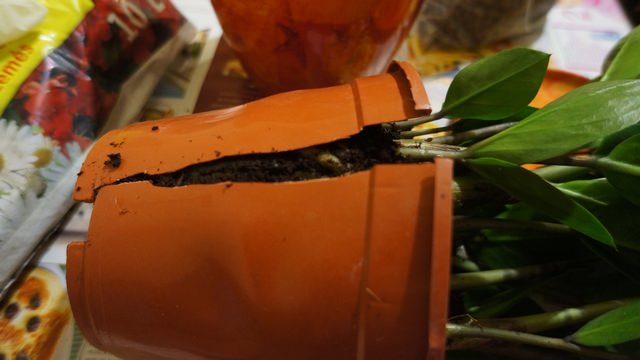

Zamiokulkas transplant at home - basic rules
Correct transplantation is the main guarantee of the continued health of the plant.
When to transplant
Zamioculcas of the first few years of growth should be replanted every year.... Since this flower grows rather slowly, in the future it is enough to do this once every two years. In this case, it is imperative to take into account the period favorable for transplanting, the composition of the soil and the requirements for the planting capacity (size, material).
Soil and drainage
Zamioculcas needs a nutritious, loose soil. You can compose it yourself using the following components:
- Sod land - 3 parts;
- Leafy land - 2 parts;
- Peat - 1 part;
- Humus - 1 part;
- Coarse sand - 1 part.
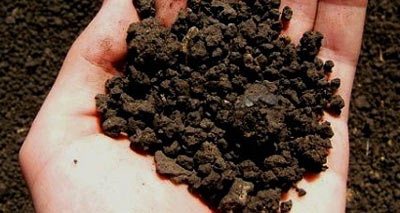

The resulting soil mixture must be thoroughly mixed and a small amount of crushed charcoal must be added to it.
You can also purchase special soil for cacti and succulents and add a small amount of coarse sand and perlite to it.
This will increase the moisture and air permeability of the substrate.
What a pot for a plant
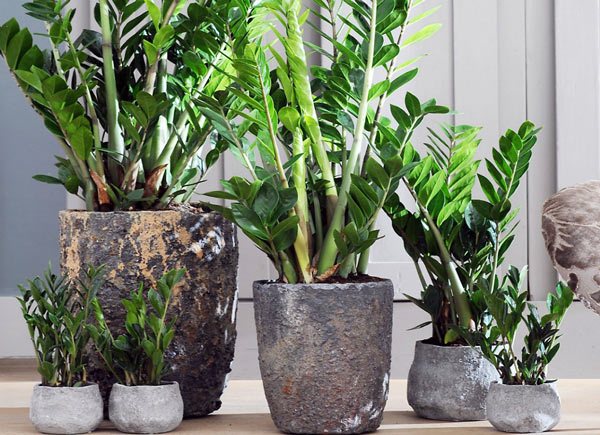

When choosing a pot for planting and further transplanting zamiokulkas, you need to adhere to certain rules that will allow you to get a large and strong flower:
- The diameter of the container should exceed the size of the root system by no more than 5 centimeters. If the pot is too large, then the growth and flowering of the transplanted flower will be inhibited until the roots cover most of the soil. Frequent waterlogging of the soil may also occur, which negatively affects the condition of the flower;
- The most suitable for planting this flower are low, wide containers with a large number of drainage holes. It will be much easier to remove large specimens from pots with this shape during subsequent transplantation;
- Since the slightest damage to the tubers or rhizomes of the zamiokulkas during transplantation adversely affects its condition, you need to carefully consider the material from which the pot is made.
Of course, ceramic containers are the most moisture and air permeable. But, if during transplantation it is not possible to easily extract the plant from them, they have to be broken, as a result of which, the fragments damage the root system. In this case, plastic pots can be carefully cut and the flower can be freed without any problems.
How to properly transplant zamioculcas: a step-by-step guide
The easiest way is to transfer the plant. At the same time, there is no risk of damage to the roots, and the zamiokulkas that got into the new soil continues to grow without loss.
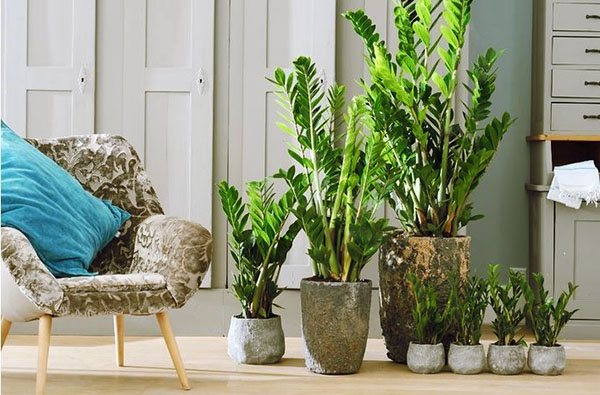

If we are talking about an adult plant, before transplanting zamiokulkas at home, as in the video, you need to clean the root system of the remnants of the old substrate:
- A plant consisting of several tubers and shoots extending from them can be separated and, having turned into several independent plants, planted in their pots. This will simplify the care of zamiokulkas and increase the home collection of the florist.
- A layer of large expanded clay is poured onto the bottom of a pre-selected pot with drainage holes to drain excess moisture.
- A little moist substrate is laid on top of it so as to completely cover the drainage and leave room for comfortable placement of the root system of the zamiokulkas.
- The filling of the roots is carried out in such a way that the apical parts of the roots and tubers are on the surface of the soil. At the end of the process, the substrate is carefully compacted.
- Expanded clay, pebbles or other suitable mulching material are laid on top of the soil to conserve moisture and protect the soil from excessive compaction.
Post-transplant care
In order for the zamioculcas to quickly take root and gain strength after transplantation, you need to carry out regular and proper care after it. It does not require special efforts and time-consuming, you just need to study some of the features of the plant, as well as regularly conduct preventive examinations for the presence of diseases and pests and take timely treatment measures.
After transplanting, the flower pot must be placed in a shaded, warm room before rooting. Then you need to choose a suitable permanent growth site for him.
The plant does not have special requirements for illumination, therefore it can grow in both shaded and well-lit places. In a strong shade, you can place large specimens, a strong growth of which is undesirable. If the zamiokulkas is located in the southern part of the room, then in a particularly hot time, it should be given additional shelter from the direct rays of the sun.
This flower is a heat-loving plant.Therefore, in the warm season, he needs from 25 to 30 degrees Celsius, and in winter the air temperature should not drop below 15 degrees. Since under natural habitat conditions, zamioculcas grows in arid places, the humidity of the air does not really matter for it.
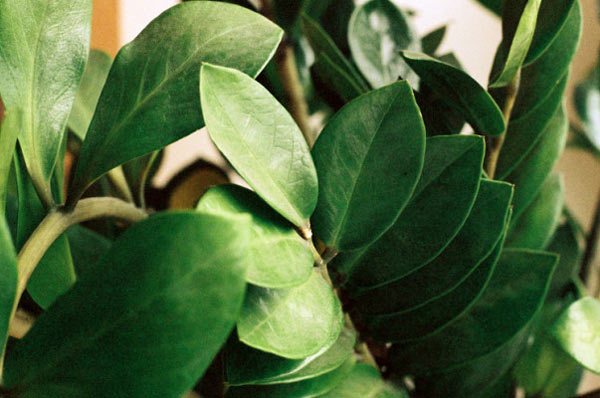

Therefore, it easily adapts to different conditions and can be skipped over spraying. But, at the same time, you need to regularly wipe its foliage in order to clean it of dust and preserve its decorative effect. The plant will also benefit from having a monthly warm shower.
Due to its origin and place of growth in the wild, zamioculcas has the ability to accumulate water. Therefore, its watering in warm weather should be abundant, but as the soil dries out. In winter, they need to be reduced to 2 times a week. With frequent overflows, root decay may begin, and then the leaves turn yellow.
In order to prevent the death of the plant in this case, it is necessary to dry the soil and further observe the irrigation regime. If, for some reason, the zamioculcas found itself in conditions of prolonged drought, small leaves begin to dry out and fall off. In this case, do not despair either.
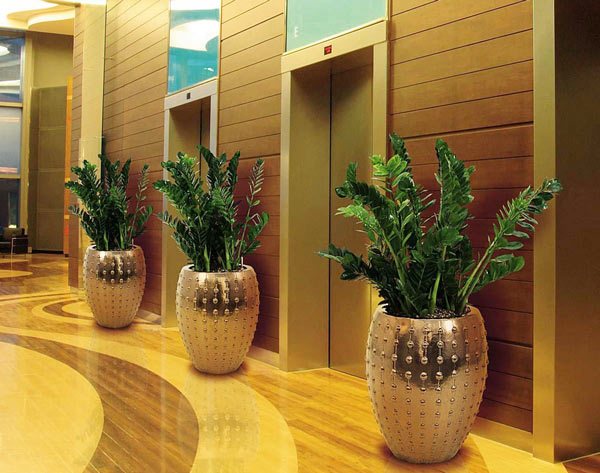

Even if the plant has lost all the leaves, it can recover from the tubers. To do this, you need to start it regularly, but water it little by little. When leaves appear, you can resume abundant watering, but as needed.
The first feeding of zamiokulkas should be carried out no earlier than 2 weeks after transplantation... In the future, the plant must be fed 2 times a month using complex mineral fertilizers. It is also recommended to spray the foliage with special nutrient formulations. With the onset of autumn, feeding is stopped until the beginning of spring.
Despite the exotic species of zamiokulkas, it is not a capricious plant. Subject to the rules of maintenance, it does not cause any difficulties in growing. Once again, briefly about how to transplant zamioculcas and take care of it after that in this video:
His transplant is usually successful, and further care is not a problem. But, this is possible only with the knowledge and implementation of some of the subtleties inherent in this plant. As a result, with minimal physical and time costs, you can get an excellent decoration for your home or office space.
Zamioculcas or "dollar tree" attracts lovers of indoor plants for its unpretentiousness and ease of care, the only thing that can cause difficulties in growing is the transplantation of zamioculcas at home.
In order not to make mistakes when growing and transplanting a plant, you need to know its main features and the rules for caring for it.
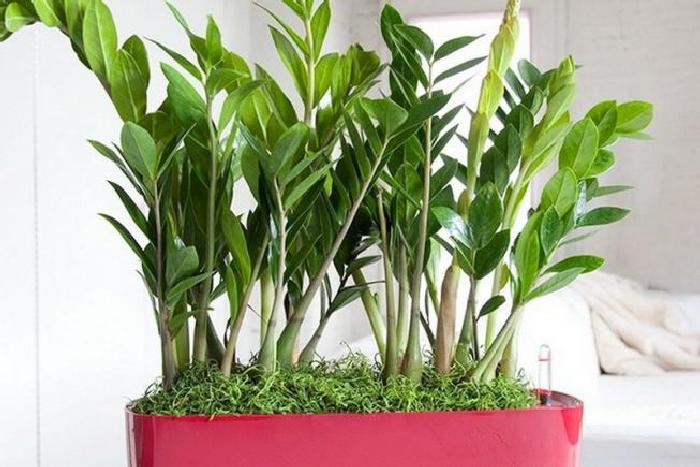

Features of the
Zamioculcas is a popular houseplant that is characterized by dense, succulent foliage and ease of maintenance. The only obstacle in growing it may be a transplant, it must be done correctly and with strict frequency. This flower is also called the "dollar tree" - according to old beliefs, the plant can attract well-being and prosperity to the house.
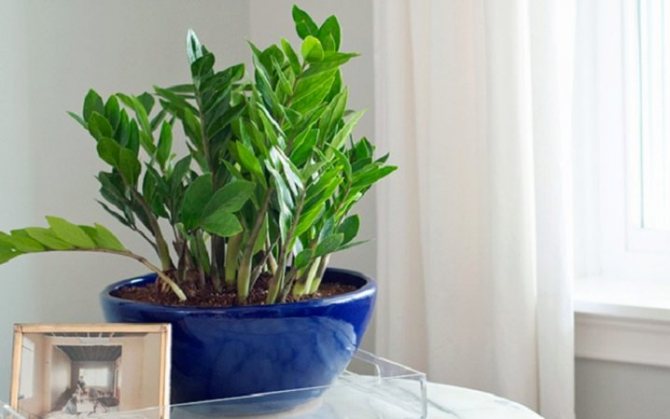

The decorative flower of this species is classified as a slow-growing crop., since with proper home care, it grows on average by only a few centimeters per year, while its maximum height does not exceed 1 m.Like all representatives of the succulent family, zamioculcas has a developed root system. Therefore, the roots of the "money tree" grow rapidly and fill the entire space of the pot, requiring timely transplantation.
Experts recommend replanting such a plant 3 weeks after purchase, since this time is enough for it to acclimatize.
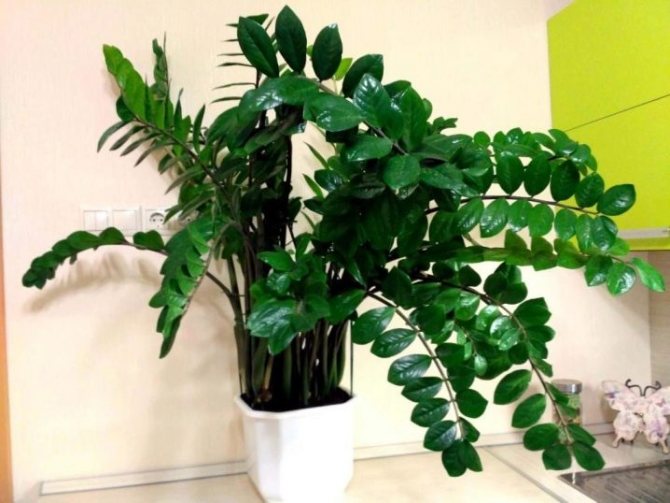

Flowers that grow in natural conditions are not afraid of the scorching rays of the sun and drought, thanks to which they perfectly adapt to any climatic conditions. The main feature of zamiokulkas is a pronounced decorative appearance and an interesting structure, the flower does not branch. That part of the "dollar tree", which is considered to be the stem, is a complex leaf, their formation begins directly from the tuber.
When growing a plant, you need to pay special attention to the lower part, since it plays a huge role in growth - it accumulates moisture.
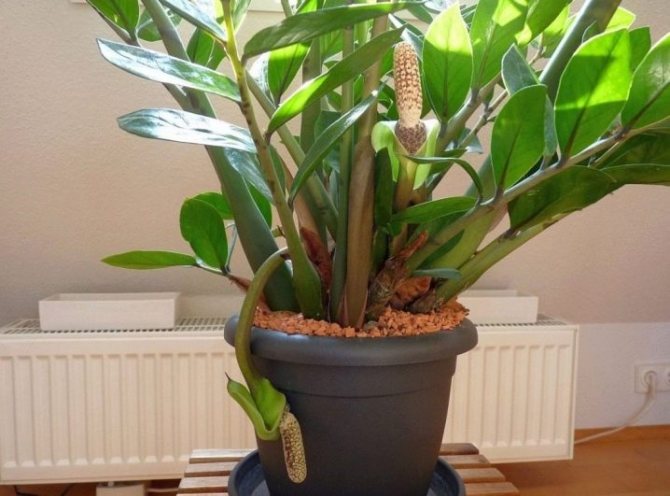

The leaves of the flower are large, they are feathery, erect, and covered with a light waxy bloom. The foliage is placed on thick stalks that form immediately at the base. Outwardly, the decorative flower resembles a small ear of corn, encircled in a circle with a veil of a pale green hue. As for the longevity of the plant, it usually grows at home for no more than 10 years, after which it needs to look for a replacement.
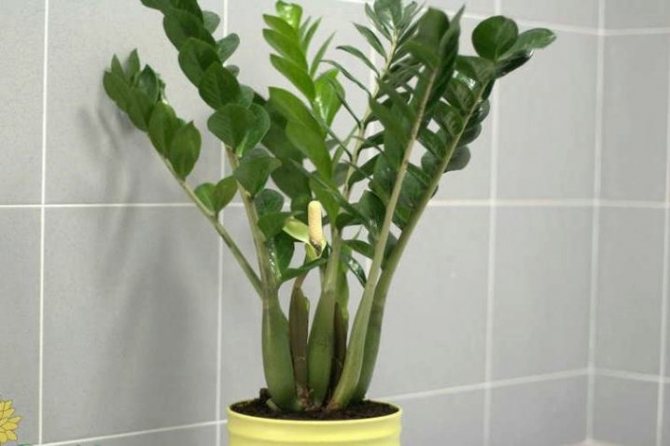

It is also worth noting that zamioculcas is classified as a poisonous plant species, any part of it can pose a danger to life. Therefore, in order to protect all family members and animals from poisoning, it is recommended to place the flower in places where it is difficult to reach.
You should be especially careful with the juice of the flower; care must be taken in such a way that the poisonous liquid does not get into the eyes.
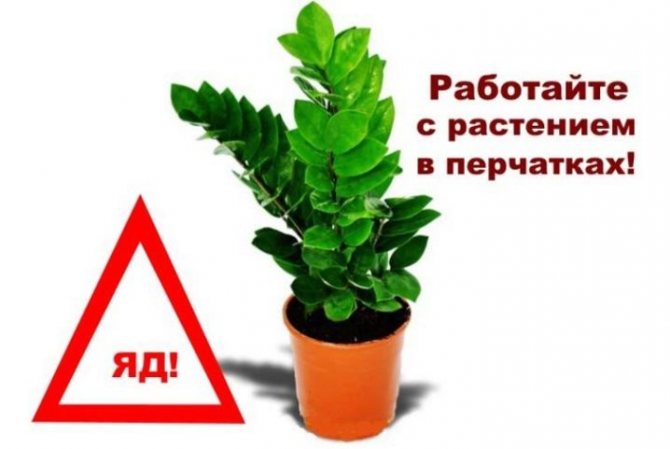

Biological characteristics and features of care
Zamioculcas is an evergreen herb with thick tubers and fleshy pointed leaves. Mature plants can bloom with proper home care. The flower is shaped like an ear of corn and hides in the axils of the lower leaves. For its resemblance to a palm tree, it is called the emerald palm tree or the Zanzibar pearl.
Essential factors for proper cultivation
| Indicators | Spring Summer | Autumn winter |
| Temperature regime | + 21-29 о С | + 18–20 о С, critical limit +15 о С |
| Humidity | Spraying, washing leaves for a bright gloss, well put in the rain | Irrelevant |
| Watering | Abundant, but infrequent. Avoid overflow and stagnation of water in the pan, otherwise root rot and stem rot are possible. May shed leaves during dry periods | Soft water when the soil is completely dry, no more than 1-2 times a month. |
| Lighting | A bright place, in the shade the leaves will shrink. In strong sun, leaf burns are possible, the light should be diffused | As bright diffused light as possible |
| Fertilizer | Fertilizers for cacti - once a month, do not overfeed | Not recommended |
However, even with the observance of all agrotechnical methods of cultivation, the plant may begin to "wither". One of the reasons for this is the delay or absence of the dollar tree transplant.
What to look for when transplanting a plant into another pot
The best method for transplanting zamiokulkas at home is the transshipment method. With it, it is not recommended to clean the root of adhering clods of earth, so as not to damage it, but to roll it along with an earthen clod.
In addition, it is important to pay attention to the following aspects:
- The best time for transplanting is considered to be March and April, with the optimal amount of heat and a suitable level of lighting;
- When transferring the rhizomes to a new container, it is not recommended to completely cover them with soil. This will help to avoid waterlogging and, as a result, decay, which is dangerous for the flower;
- If, during transplantation, rotten roots were found at the root, they must be carefully separated from the general coma in order to stop the spread of the problem;
- It is recommended to transplant zamioculcas into a nutritious substrate, in which clean sand, peat, leafy soil with the addition of humus are included in the same ratio. To increase air permeability, it is recommended to add crushed expanded clay;
- At the bottom of the pot, before transplanting, place a drainage layer of small pebbles or stones;
- The first watering of zamiokulkas is recommended not earlier than two days after transplanting the flower into a new container.
After the plant has finally settled into a new pot, it is important to monitor the development of the root. This will help to notice in time the moment when the flower needs to be transplanted without harm to it.
How to understand that Zamiokulkas needs a transplant
There are several signs by which it is clear that the plant needs a transplant.
- The roots do not fit in the pot, they are cramped;
- The planting capacity is deformed and cracked from the growing roots;
- The soil is very compacted, not loose, poorly air-permeable;
- The plant stops growing;
- The water-storing tuber begins to grow;
- Leaves curl, wither and dry.
There are 3 obligatory transplants:
- after the purchase;
- annual transplanting of young plants;
- transplanting old plants every 3-4 years.
Features of zamiokulkas
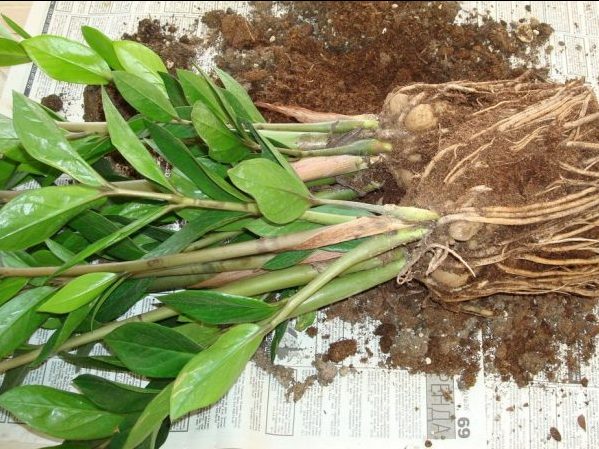

Zamioculcas: transplant
This plant has no relatives - it is the only representative of its kind. The Latin name is Zamioculcas zamiifolia. Natural habitat - the tropics of Africa. Special growing conditions have shaped its appearance and structure:
- thick rhizome in the form of a tuber, capable of accumulating nutrients and moisture; under natural conditions, its diameter is up to 0.5 m, in a room with intensive growth it may well destroy the pot in which it lives;
- glossy, dark green long leaves, reaching one meter in nature, they have a complex pinnate structure;
- swelling at the base of the leaf plate serves the same purposes as the rhizome;
- a modest flower in the form of a cob wrapped in a pale green blanket, which appears at the very surface of the soil, is rarely admired in room culture.
Zamioculcas responds to frequent droughts at home by dropping evergreen leaves. The harsh conditions developed in the plant qualities that are valuable for room culture: unpretentiousness and plasticity. It easily adapts to lack of light or slightly low temperatures. The only thing that the flower does not tolerate is high humidity. Loose roots are used to dry soil and rot easily.
When is the best time to replant
The best time for transplanting for both a young and a mature plant is spring, the most favorable months are March and April.
Experienced growers wait until the end of the flowering of the plant, and only after that they begin to transplant, otherwise the plant will drop all flowers.
Young plants are transplanted annually, as their growth is intensive for up to 3 years. It is necessary for them not only to change the size of the container, but also the soil due to its depletion.
Mature specimens try not to disturb so often, especially since the growth of the plant slows down with age, so they are transplanted every 3-4 years.
If the moment is missed, a transplant can be carried out at the beginning of summer.
Some indoor plant lovers believe that an autumn transplant is possible without much discomfort for the flower, although experts believe this is incorrect. During this period, the flower prepares for a state of dormancy for the winter and all processes in the plant are inhibited, therefore, there will be no good survival rate.
Transplant time and frequency
A particular difficulty in caring for the "dollar tree" is a transplant, which cannot be carried out immediately after the purchase of the plant. The purchased indoor flower must be placed in a good place with moderate lighting and given some time to acclimatize.
Experts recommend placing it in "quarantine", placing it in rooms where there are no other decorative flowers.
During acclimatization, it is important to monitor the condition of the flower, and water as the soil dries up. In 3-4 weeks after purchase, zamioculcas can be transplanted.
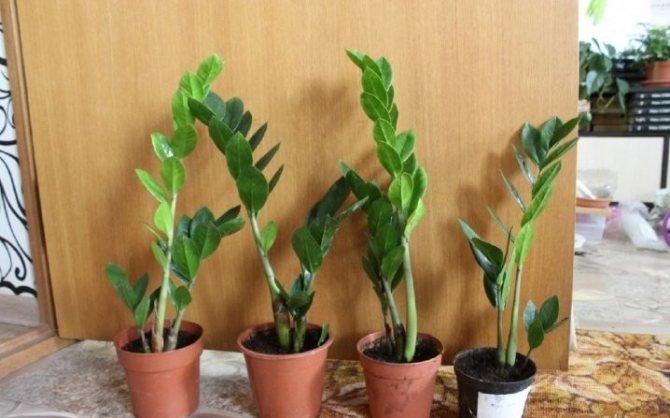

It is best to transplant in winter and spring, choosing the period from late February to early March. If you assign such an important procedure for another season (autumn or summer), then the plant may take root badly and get sick. At the same time, it is advisable to transplant all young flowers into large pots every year, while "mature" plants require transplantation less often, and it is carried out as the container is filled with roots.
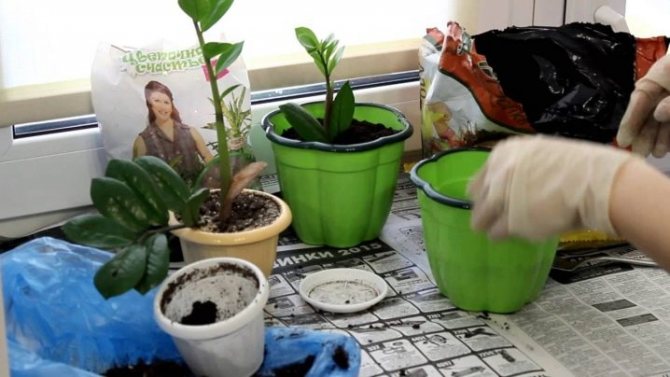

Transplant methods
Any houseplant requires a transplant. Transplants are:
Scheduled transplants are necessary when the soil is depleted, the pot is small or the flowers have stopped growing.
An emergency transplant is carried out if there is a suspicion that root decay has begun or that any diseases or pests have been detected.
According to the method of transplantation, 2 types are distinguished: the actual transplantation and transshipment.
Transplanting is moving to another pot with the complete elimination of old soil.
The roots are completely cleared of soil, washed, pruned, if necessary, and placed in a new container with fresh potting soil. With this method, the plant is sick for a long time.
Transshipment is a method in which a clod of earth is not disturbed, the plant is moved to a larger pot, and all gaps are covered with earth. With this method, the plant does not get sick, it quickly grows the root system and leaves.
Zamioculcas are transplanted only by transshipment. An exception is the transfer from the transport mixture. This is dictated by the fact that the roots of the plant are very fragile and can be deformed with another method of transplantation. For less damage to the roots, a clod of earth is poured abundantly with water before transshipment.
The form
It is worth paying the necessary attention to the choice of the shape of the flowerpot for planting zamiokulkas, adhering to the following recommendations:
- the plant cannot be planted in a container with a narrow top, since the roots of the plant grow intensively, and the narrow neck of the flowerpot will complicate its next transplant;
- an excellent option for zamiokulkas would be the choice of a low pot;
- it is preferable to purchase a container in which the bottom will be narrower than the outlet, which is associated with the growth of the stems of the indoor plant.
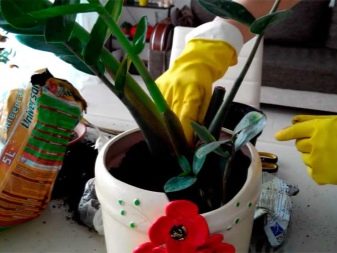

Preparing for transplant
In order for the transplantation of zamioculcas to be successful, it is necessary to carry out a number of preparatory measures.
Pot selection
- The size of the pot should be 10-15% larger than the previous one, it is no more than 3 cm in diameter. The root system should fit freely in the pot, but there should be no voids. You cannot choose a pot with a margin, since in this case the plant stops growing the aboveground part. It will begin to form new leaves only when the root system fills the volume of the new container completely. In addition, alkalization of the earth can occur.
- The pot must be stable, as the weight of the plant increases rapidly with further growth.
- The container must have drainage holes.
- The most comfortable shape for a zamiokulkas pot is a wide flowerpot with a narrowed bottom.
- The pot can be earthen or plastic.
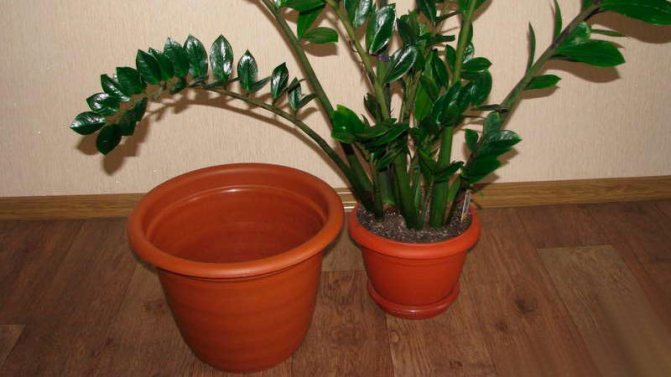

Clay pots
| pros | Minuses |
| The porous structure allows air to pass through well, excess moisture evaporates | High price |
| Large mass, the pot will not fall from the weight of the plant | Salt streaks form on the surface of the pot |
| Durable | Glazed pots don't fit, they don't "breathe" |
| Performs the role of a thermostat: cool in summer, warm in winter | When transplanting, you have to break, which is quite expensive |
Plastic pots
| pros | Minuses |
| When transplanting, you can cut the pot | They retain moisture for a long time, root rot may begin |
| Low price | Possible overheating in the sun due to the structure of the plastic |
| Various colors, the ability to match to any interior | Rapid deformation from overgrowing roots |
| Easy to wash and clean | Air access is limited by artificial material |
| Lightweight, easy to carry | Lungs, may tip over, damage to the plant will occur |
Soil preparation
Basic requirements for the soil:
- Should be light and loose, with good air access;
- Possess drainage properties (the earth is mixed with fine expanded clay or screenings);
- The composition of the soil: sod land, leafy soil, peat, sand in equal proportions, or a soil mixture for cacti and succulents, it is possible to introduce a small amount of humus;
- Do not use clay soil, this leads to root rot due to its poor permeability;
- Do not use very nutritious soil, the plant can get sick due to an overdose of fertilizers in it;
- Disinfect with boiling water or roasting in the oven before transplanting.
Required model
To find the right pot model, there are several rules to follow.
- It is important not to forget that there must be drainage holes in the plant container. Excess moisture will be removed through them. There should be a lot of holes in the bottom of the container. In order for the plant to consume the correct water level, it is necessary to avoid stagnant liquid in the pot. To do this, it is best to pick up a flowerpot, at the bottom of which there will be large holes.
- The pot material can be either plastic or clay. It must be remembered that damaged plastic products produce harmful substances that can negatively affect the growth and health of the plant. Transplanting from a clay container is more difficult, since it is difficult to get a flower out of a pot, especially for inexperienced growers, often the root system is damaged.
The difference between the plastic container is that it can be cut in order to get the roots whole.
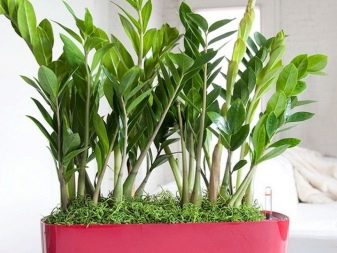

- Avoid purchasing a glass pot for zamiocalcus. In such a container, the soil will retain moisture for a long time. Do not forget that dry, well-ventilated soil is a favorable condition for the growth and development of this plant. Otherwise, due to excess moisture, the roots can be exposed to diseases and decay, which leads to the death of the plant.
- Pots made from peat and coconut fiber are commercially available. The advantage of such models is that the soil is well ventilated, and moisture does not stagnate, which leads to drying out of the soil. It is difficult for Zamiocalcus to tolerate not only wet soil, but also drought, which is its paradoxical feature.
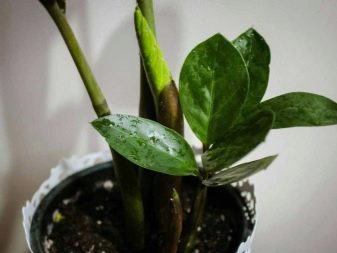

Transplant process step by step
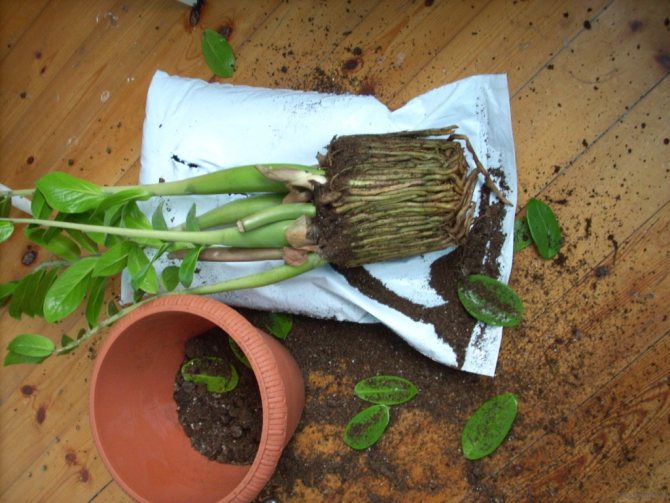

- Prepare in advance a new container, drainage, soil mixture.
- Sprinkle the plant with water 24 hours before transplanting so that the clod of earth is moist.
- When using a new clay pot, soak it in water for several hours so that it does not take water from the soil, disinfect the plastic pot.
- Pour expanded clay into the pot with a layer of 2-3 cm.
- Pour prepared soil. It is advisable to warm it up to 25-30 degrees, this will reduce stress for the plant.
- Carefully remove the dollar tree from the old container.
- Conduct a thorough examination of the root system. Remove damaged or rotten roots, divide overgrown roots for further propagation.
- Lower the zamioculcas into a pot, spread the roots and cover with soil, tamping slightly, while the tubers should be slightly on the surface (0.5 cm).
- A small amount of expanded clay is placed on top of the soil.
- Do not water the plant for 2-3 days.
Caution! Zamioculcas leaves contain poisonous cell sap, so you need to be careful and work only with gloves, allergic reactions are possible.
Is the soil suitable for zamiokulkas for cacti, which land is better to buy
If there is no opportunity, or there is not enough experience for independent production of the substrate, do not despair. Ready-mix can be purchased at any specialty store.
The most common are:
- Soil for cacti and succulents - provide good air permeability, which is important for the normal growth and development of the flower;
- A versatile substrate mixed with sand and a small amount of expanded clay or perlite.
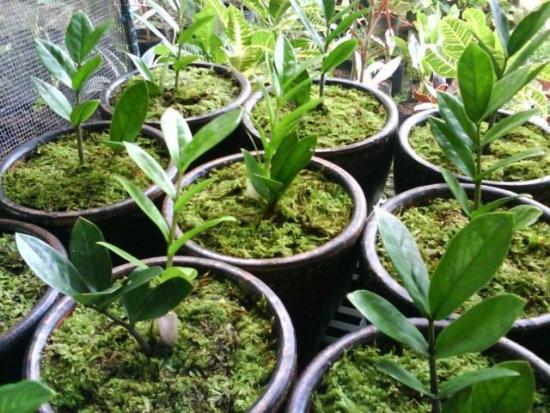

These mixtures are in no way inferior in quality to those made with our own hands. In addition, the mixtures purchased in the store can be a real salvation for a novice gardener, because they will reduce the danger of making mistakes and ruining the plant to a minimum.
Plant care after transplant
After transplanting, the plant must be at rest for some time in order to adapt to the new soil and to the new volume of the pot. Then, normal care is resumed. Zamioculcas does not like increased attention and excessive care.
The dollar tree enjoys well-deserved attention from flower growers not only for the splendor and brightness of the leaves, but also for the fact that it reduces the symptoms of depression, improves mood. fast wedding.
How to properly trim zamiokulkas?
If you need to form a plant, propagate it, or renew old foliage, use pruning. In case of flower diseases, they also use this method.
Both tuberous and leafy parts are cut off. Use a short, sharp knife or pruner.
On a note! The treated area must be dried so that harmful microorganisms do not enter it.
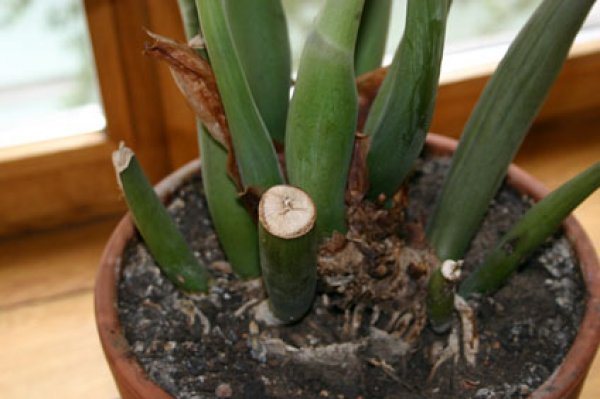

The plant can be pruned regularly
So, you need to carefully observe the temperature regime, select the correct lighting and moderately fertilize the zamiokulkas. If some criterion is not met enough, others need to be reduced - for example, if there is little light, less watering and a lower temperature are needed. If any criterion is excessive, others are also raised - on hot days they provide more light, water and fertilizers.
How to choose a pot for zamiokulkas
Aside from soil, the dollar tree is very demanding in terms of growing capacity.
So, when choosing a pot, it is recommended to remember that:
- The volume of the container should not be sufficient for the root system to completely fit in it. If there is too much free space, there is a danger of stopping the growth of the ground part of the plant until the root completely occupies the free areas of the soil.
- The optimal size is an increase in the volume of each new pot by 10-15%.
- There must be drainage holes at the bottom of the vessel, which will help prevent root decay.
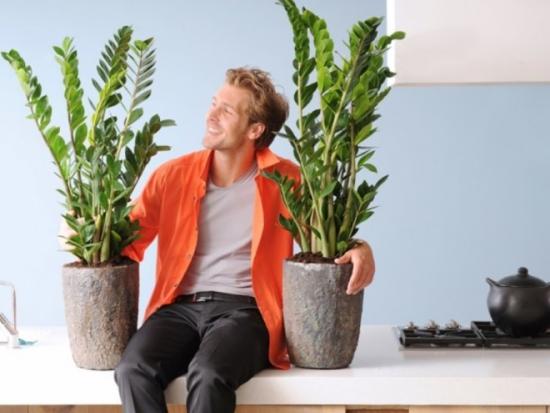

The material of the vessel for zamiokulkas does not really matter. But it should be borne in mind that when planting in clay pots, the risk of rot formation is significantly reduced, since such material contributes to the speedy drying of the soil.
The only drawback of clay pots is the difficulty of transplanting, since it is not easy to extract a plant without damaging its root from such a container.
Plastic containers are in many ways superior to other options in terms of the price category and their properties. So, when transplanting, plastic can be bent or cut with minimal damage to the root.
Choosing the right container for planting a plant is one of the important aspects that you should pay attention to when transplanting. Too large a pot or lack of drainage holes can negatively affect the condition of the flower.
Soil for zamiokulkas is one of the most important points to which you should pay special attention.
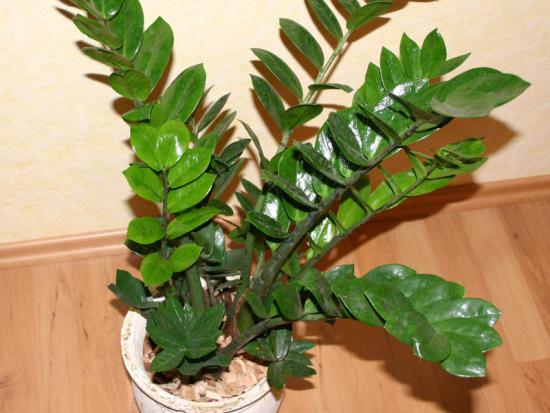

It is important to remember that the root of the flower needs a sufficient amount of oxygen, which loam or other dense soils cannot provide.
Therefore, when choosing a substrate, you should pay special attention to the level of air permeability.
We offer you to watch an interesting video about planting zamiokulkaks:
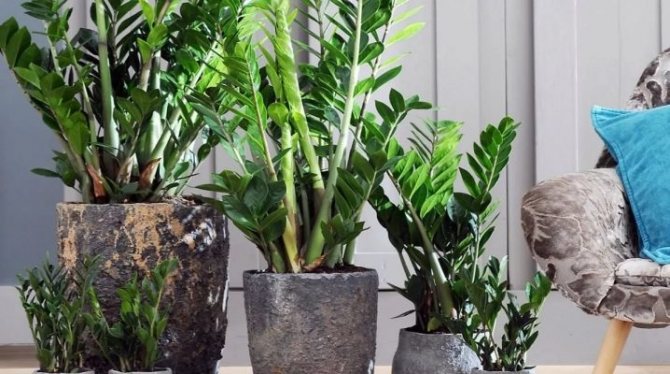

Zamiocalcus is one of the most popular indoor plants today.It was chosen by many flower growers because of its bright green foliage and massive stems. But for good growth and appearance of a dollar tree, careful maintenance, suitable soil, timely watering, lighting, and also a properly chosen pot are necessary.
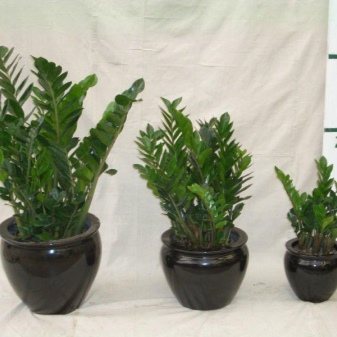

Choice of capacity
Before transplanting zamiokulkas at home, you first need to choose a pot of the right size and shape for the plant. You should not plant a flower in a cramped potas its rhizome grows rapidly and fills it. But a container that is too spacious should also not be chosen.
In a large pot, zamioculcas grows very slowly. The intensity of its growth increases only when the rhizome begins to rest against the walls of the pot.
Therefore, for a plant, the capacity should be slightly larger than the size of the root.
Shape is also important for this flower. Better to take a short and wide potfrom which the flower will be easy to extract at the next transplant. Moreover, its roots will suffer less.
Choose plastic pots for zamiokulkas... In ceramics, through which water evaporates, the plant feels bad, experiencing a lack of moisture and a decrease in temperature during the evaporation process.
In addition, it is important not only what kind of pot is needed for zamiokulkas, but also what kind of land.
Other difficulties
There are some more nuances of plant maintenance:
- Broken leaf of the flower. This part must be placed in water. After 3-4 months, roots will appear and the possibility of planting a new plant. When rooting, you need to regularly change the water so that it is always fresh. The process can be accelerated by adding Kornevin to the water.
- Cessation of growth. When the volume of the pot is not enough or the lighting is insufficient, then this can slow down the growth of the plant. The flower grows well in sunny places and in partial shade. But there will be no active growth in highly darkened areas. Stunted growth can be due to improper transplantation, root damage, or infection. Roots rot from waterlogged soil. Watering should be done carefully, between waterings the soil should dry out by 3-4 cm. An unsuitable soil mixture also worsens the condition of the plant.
If there are non-decayed root tubers, they should be planted in cactus soil. It is necessary to clean the tuber of soil residues, rinse in a weak solution of potassium permanganate and dry. Then rotted roots are removed, part of the tuber is removed. Sections must be sprinkled with ash, it is allowed to sprinkle with "Oxyhom", "Fundazol". These funds allow you to process the aerial part of the plant. The container must be disinfected, the soil must be replaced.
What does zamioculcas look like?
It is easy to recognize this plant, because it looks quite unusual and very picturesque. In the ground there is a large root-like brown tuber. It stores moisture. Several feathery leaves rise above the earth's surface - usually from 4 to 6 of them grow. They reach 100 cm in length.
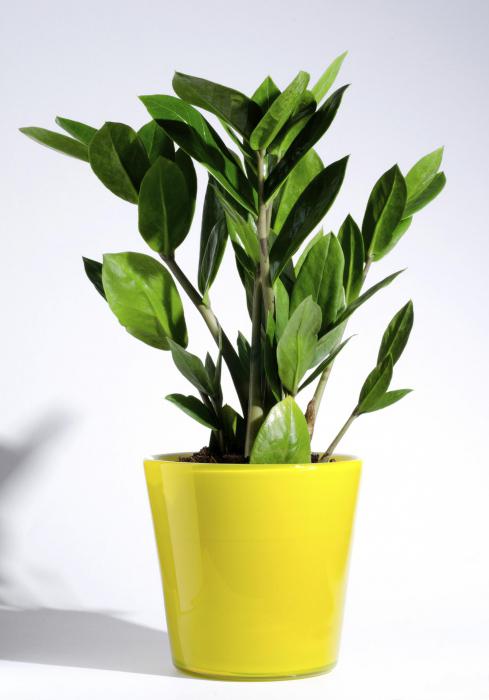

Their fleshy petioles are often mistaken for trunks, because they look like powerful, highly developed and somewhat swollen stems. The feathery leaves of the zamiokulkas are covered with dense, glossy leaf plates that have a rich dark green color. In the natural environment, this beautiful flower, like other representatives of the aroid family, produces pale green inflorescences in the form of cobs, surrounded by "blankets". When grown at home, it rarely blooms. However, from an aesthetic point of view, the inflorescences of zamiokulkas do not look very attractive, so many plant breeders do not strive to achieve flowering. And without white-green "cobs" zamiokulkas looks beautiful and brightens up any room.
How to care for a flower called zamiokulkas: general provisions
This houseplant usually does not cause much trouble for the owner. It prefers soft, diffused light, but at the same time is not afraid of direct sunlight.Therefore, you can choose a well-lit southern, eastern or western window sill and put your zamiokulkas on it. The photo shows the correct placement of the pot with the plant.
In summer, it is recommended to take it out to the balcony or veranda. On the street, the plant will gain strength and grow stronger. Lack of light has a bad effect on the appearance of the zamiokulkas - the leaves of the plant become weak and thin, with rare or far-growing leaf blades. Zamioculcas prefers moderate temperatures - in summer within 20 ° C-25 ° C, and in winter - 16 ° C-18 ° C. It is not recommended to keep the plant in a cold room (below 15 ° C) or expose it to drafts. Otherwise, it can get sick. Air humidity for Zamiokulkas, a native of Africa, is not as important as lighting. He calmly transfers the dry air of an ordinary city apartment.
Watering and feeding the plant


As for watering, it should be moderate from spring to autumn. it should have time to dry before the next moistening. In winter, with a cool content, the substrate in the pot is moistened even less often, about one to two times a month. In addition to watering, it is advisable to sometimes wipe the leaves with a damp cloth to wash off the dust. Top dressing of zamiokulkas is carried out only in the spring-summer period, once or twice a month. In this case, special fertilizers are used for cacti or succulents. Next, we will tell you how to transplant zamiokulkas after purchase.
Watering rules
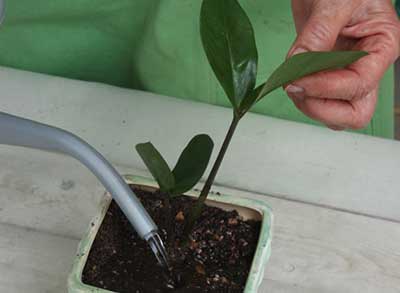

If your money tree does not grow, this does not mean that it needs to be watered more often!
The biggest mistake of newcomers is that they flood zamioculcas, and for an "African" it is much worse than a drought.
He needs water only after he completely absorbs what is already available, so always wait for the soil to dry completely. As for the quantity, the liquid should be so much that it saturates the ground throughout its depth.
What to do after buying a flower in a store
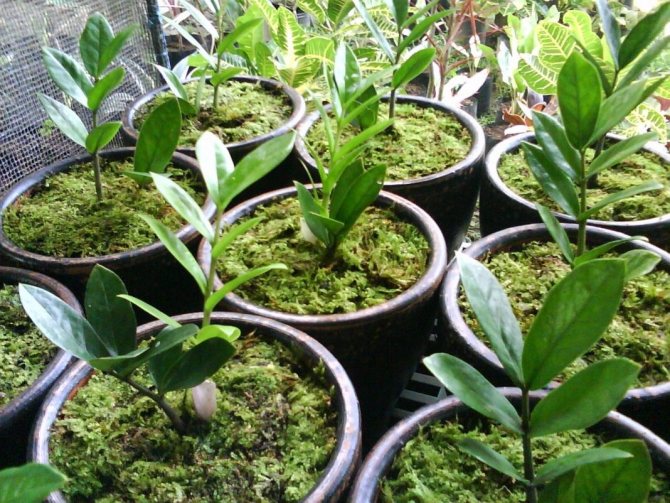

After you purchase a flower from the store, let it stand indoors for a couple of weeks. This is important in order for the stress associated with a change in habitat to pass, after which he will need a mandatory transplant into another container. Shipping pots are not suitable for a long stay, of course, unless you bought a plant along with a capacity worthy of its development. Why you need to replace the pot:
- As a rule, all transport containers are filled with peat substrate, this temporary filling does not allow watering, and the plant can be easily flooded or overdried.
- Inside such a temporary "shelter" there are large openings that act as drainage. If the plant is kept in such a pot for a long time, its roots penetrate through the holes and it is difficult to transplant the plant later without damaging the rhizomes. And this will directly affect the well-being of the flower.
As you can see, there are enough reasons for a transplant. But one has only to place it in a normal pot, the zamioculcas will instantly react and after a short adaptation it will move into growth, increasing its stem and leaf mass.
Possible problems
Despite the fact that it is quite easy to care for exotic Zamioculcas, a number of problems can arise during cultivation. Some of them are caused by incorrect transplantation.
| Problem | Cause | Decision |
| Loss of foliage | Excessive moisture / prolonged drought. | Systematize the irrigation system |
| High content of peat or clay in the substrate. | Transfer to the most suitable soil mixture | |
| Suspension of development | The plant grows in a pot that is too large, and therefore uses reserves for the development of the contents of the container by the roots | Transplanted into a container of the recommended size |
| The leaves turned yellow, became flabby | Decay of the root system. It should also be borne in mind that in adult plants, the leaves turn yellow and dry out during natural processes. | Reduce the amount of watering. If it was not possible to solve the problem in a similar way, they are transplanted into a new soil and the substrate is changed to a drier one. In the future, make sure that the moisture in the pallet does not stagnate. If necessary, the affected segments are cut off, the sections are disinfected with crushed activated carbon. |
Follow-up care
With the correct cultivation of the "dollar tree" it is very important not only to make timely transplantation, but also to provide the plant with proper care. In order for the flower to quickly grow stronger and take root, it will take a lot of effort. You also need to constantly monitor the presence of insects and the manifestation of diseases. If this is noticed, then you should immediately treat the flower with certain preparations. In addition, to accelerate growth, zamiokulkas should be placed in a warm and dark place, and when it takes root, a permanent and comfortable place is selected for it.
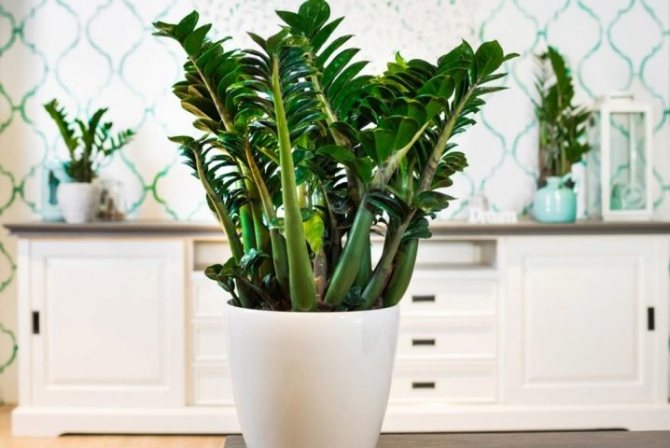

When caring for the "money tree", it is also important to consider the following indicators.
Lighting
An indoor flower is not particularly picky about the level of lighting and can grow well both in a darkened and well-lit place. As a rule, mature plants are placed in the shade when they want to slow down their growth.
It is not recommended to expose the flowerpot in the hot season on the windowsills, which are located to the south.
If there are no other accommodation options, then the "money tree" will need to provide a protective shelter from the scorching sun.
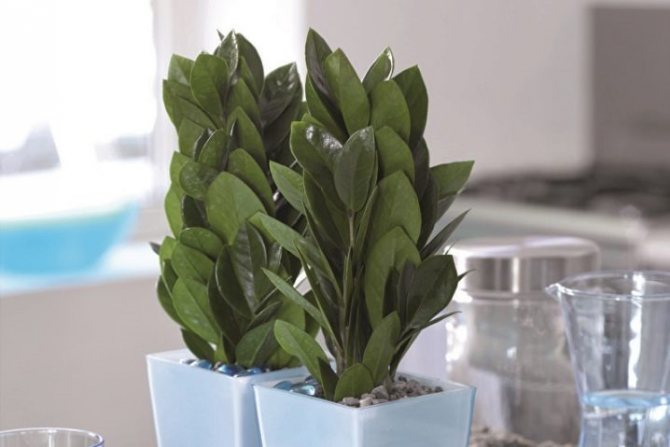

Indoor air temperature and humidity
Zamioculcas loves warmth, therefore, in summer for normal growth, it needs an air temperature of at least +30 degrees, while in winter it can drop to +15. Since in nature the flower lives in arid places, the level of humidity in the room is not important for it. This is the only indoor flower that feels comfortable even with the heating devices turned on.
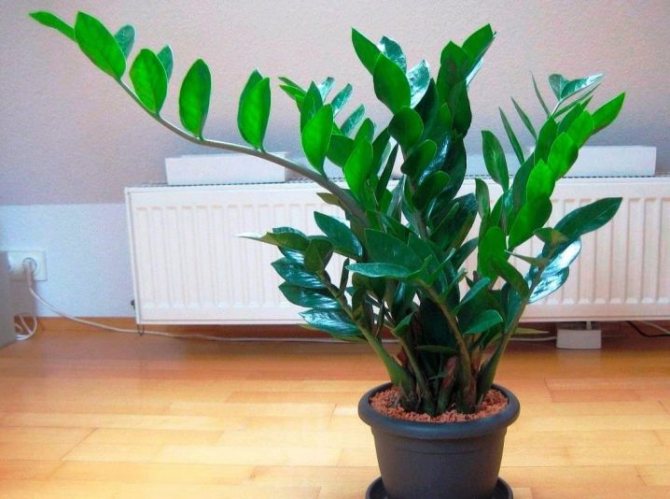

Watering
This procedure is best carried out in the form of spraying from a spray bottle. This will help remove dust from the leaves and provide moisture at the same time. In the hot season, the dollar tree should be watered more often, but not very abundantly. The water should be taken at room temperature. The need for watering is determined by the state of the topsoil - if it has dried out by 2 cm, then it is necessary to start "water procedures". In winter, on the contrary, watering is reduced, and carried out only when the soil has dried to a depth of half the capacity.
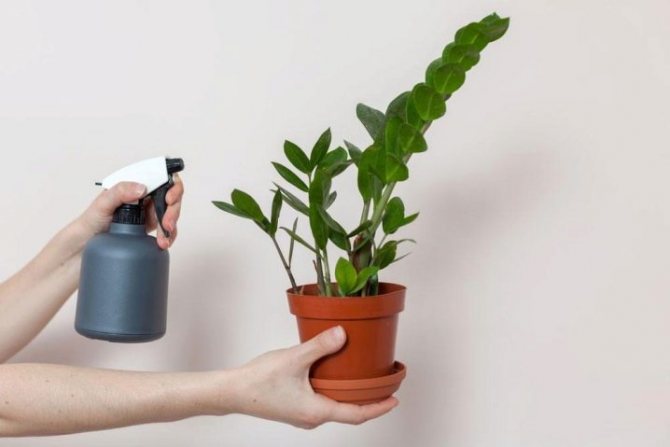

Fertilizer
Like all other decorative flowers, zamiokulkas needs periodic feeding. The plant is able to accumulate water for a long time, but it consumes nutrients very quickly. To ensure the normal development of the flower, experts recommend fertilizing in spring and summer, since it is during this period that active vegetation takes place. As a top dressing, special mineral mixtures are usually used, sold ready-made. They are introduced strictly according to the instructions, observing a certain dosage.
It is best to fertilize the plant once a month; frequent feeding can lead to its death.
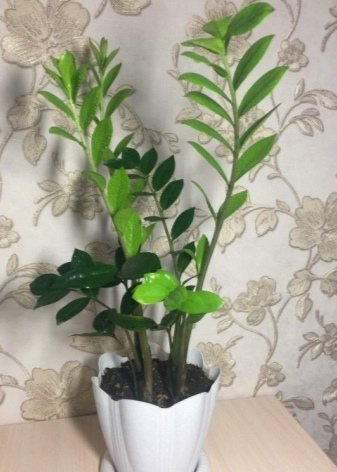

If all of the above conditions are met, then the "dollar tree" will surely grow healthy, beautiful, and will not lose its decorative qualities.
You can get acquainted with the technology of zamiokulkas transplantation in the following video.
Zamioculcas (Zamioculcas) is a large herbaceous plant belonging to the aroid.
Sometimes it is also called the dollar tree. East Africa is considered his homeland.
It is characterized by very beautiful foliage and specific inflorescences, more like cobscovered with a greenish veil.
Despite its exoticism, this flower is not picky, has great endurance and, if properly maintained, grows well in the conditions of ordinary city apartments.
But in order for zamioculcas to develop correctly, you need to know the rules for caring for it. One of them is a transplant.
Preparation of the nutrient substrate
As already mentioned, the zamioculcas contained at home does not require a large amount of nutrients, on the contrary, their excess is even harmful. Therefore, let's dwell on other properties that a good soil for a dollar tree should have.
It is not worth coming up with anything unusual. The traditional blend used for most home-grown flowers, which is based on some high ground, sand and peat, is fine. It is advisable to slightly fertilize the composition with turf and sphagnum. The main requirement for the soil is good water permeability, looseness and neutral acidity. The latter is no less important than water disposal, therefore, before transplanting a plant, you should check the acidity indicator using litmus, which can be purchased at any garden store.
Fertilizing the soil, of course, is desirable, especially with minerals and trace elements, the most important of which are potassium, phosphorus and nitrogen. But this must be done extremely carefully - exceeding the concentration of fertilizers when growing zamiokulkas is much more dangerous than their lack, therefore, it is worth strictly following the recommendations of the manufacturers of feeding complexes for their dosage.
Transplant technology
It is necessary to transplant Zamioculcas according to the instructions:
- The flower is carefully removed from the pot, if necessary, the latter is cut with a suitable tool or broken. It is not necessary to remove the earth, it is enough to slightly straighten the roots and stop the unproductive ones. If such manipulations cannot be carried out, the earthen ball is delicately rolled over a horizontal surface.
- If the tree is large and has several tubers, it can be propagated by dividing the rhizome. To do this, the underground part must be divided into a certain number of components, keeping roots and branches with growth points on each, and transplanted into different containers.
- The bottom of the flowerpot is laid out by a third with drainage, the thickness of which depends on the dimensions of the pot. In this case, the layer should be at least 3-5 cm in height.
- A little soil is poured, a seedling is placed on top, the remaining voids are filled. The substrate is lightly tamped, leaving the top of the tubers above the surface.
- Moisturize. Mulch with expanded clay, small pebbles or sphagnum.
Transplant rules
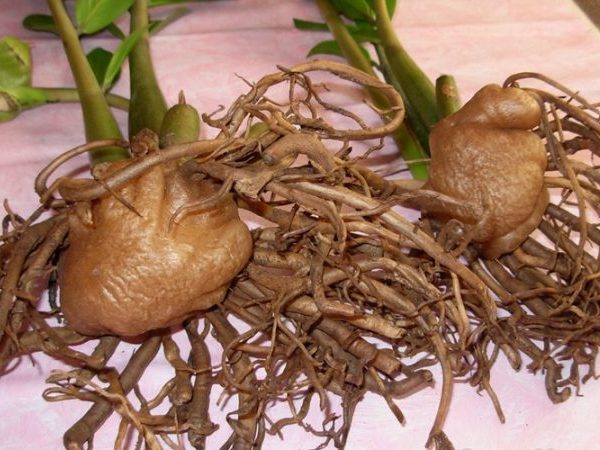

Zamioculcas: tuber transplant
They are quite simple, but they require strict adherence. The tuber itself is loose and contains a lot of moisture, the roots extending from it are fragile and easily damaged. Therefore, you need to handle the plant carefully and carefully transfer it into a new container. What else is required?
- Well-chosen pot.
- Suitable soil.
- Thoughtful care after transplant.
If everything is done correctly, relocation to a new soil will only benefit Zamiokulkas.
Pot selection
In which pot is the zamiokulkas transplant carried out? The fleshy leaves weigh a lot. Therefore, the container for planting must be selected stable. A light plastic pot can just tip over under the weight of the leaf mass, but ceramic dishes are no better. In it, the soil dries out faster and experiences a temperature drop, which is fundamental for zamiokulkus. The tuber can break plastic. But when the zamioculcas grows it too quickly, a heavy plastic pot is preferable. If the rhizome is difficult to pull out, then the issue can be fundamentally resolved: cut the container with a sharp knife.
The size of the pot is also important. You should not choose it "in reserve".Feeling freedom, the rhizome will begin to increase vigorously, while the growth of leaves is inhibited until the entire volume is filled with roots. There is a threat of acidification of the uncultivated soil, which is not good for the plant. The diameter of the new pot should not be much, only 15%, exceed the one in which the flower grew before transplanting.
Drainage holes for water drainage are required. The shape is preferable low, but wide, and the neck should be wider than the bottom.
The soil
At home, the flower grows on sand with a high content of stones. He needs light, moisture and air permeable soil in the room. You can buy ready-made soil intended for the inhabitants of the desert - succulents and cacti. Universal soil is also suitable, if you make it lighter by adding loosening components:
- expanded clay;
- sand;
- perlite.
They are taken in equal proportions and mixed with soil in a 1: 3 ratio.
Some growers prepare the ground for transplanting zamiokulkas on their own, mixing equal parts of sand and peat - for looseness, sod soil and humus from the leaves - for nutrition.
Advice! Zamioculcas flower does not tolerate heavy moist soil, planted in such soil, it gradually dies.
Zamioculcas: transplant according to the rules
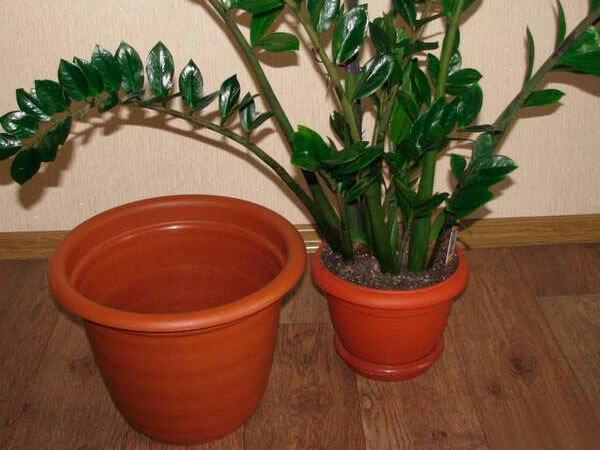

Zamioculcas: transplant, pot selection
The most important thing in this operation is not to damage the root system, otherwise it may rot. Recovery from damage will be long and difficult. Transplant algorithm:
- choose a pot of the required diameter and make 3-4 drainage holes in it, when they are not present initially, if they have already been used, the container needs to be sterilized;
- preparing the planting mixture and disinfecting it by steaming;
Advice! A good additive is crushed charcoal, which is both the prevention of fungal diseases and a substance that absorbs excess moisture.
- a quarter of the volume of the planting container should be drainage - disinfected pieces of an old clay pot, washed and steamed pebbles, expanded clay, heat-treated;
- the drainage is sprinkled with a small layer of the planting mixture;
- when everything is ready, they begin to free the plant from the old pot - they put it on its side, clasp the leaf plates with their hand and, holding the container, carefully take out the plant, sometimes you have to cut the flowerpot for this;
- without shaking off the soil from the roots, put them in the center of a new pot, pour the soil on the sides and slightly compact it with your hand - the rhizome should protrude slightly above the ground, like a turnip, they do not completely fill it up;
Advice! The exception is the change of the transport soil to a permanent one - you need to get rid of the old soil completely.
- the roots of zamiokulkas during transplantation are soaked in the pelvis, then they are revised, if necessary - pruning of decayed places, followed by sprinkling the wounds with crushed coal. You can plant a plant when the damage dries up - in a day.
- if the soil is absolutely dry, it is slightly moistened, otherwise watering the zamiokulkas after transplantation is postponed until the soil dries out.
Zamiokulkas flower transplant is completed. For an adult specimen, a support for the leaves is required, it is best if it supports them in a circle and is disassembled if necessary.
Advice! All transplant operations are best done with rubber gloves - in some people, the sap of the plant can irritate the mucous membranes and skin.
We plant zamiokulkas, choose the right soil
When planting a plant, it is important to pay special attention to the selection of soil. So, standard-quality substrates that are suitable for most indoor plants are not suitable for our flower.
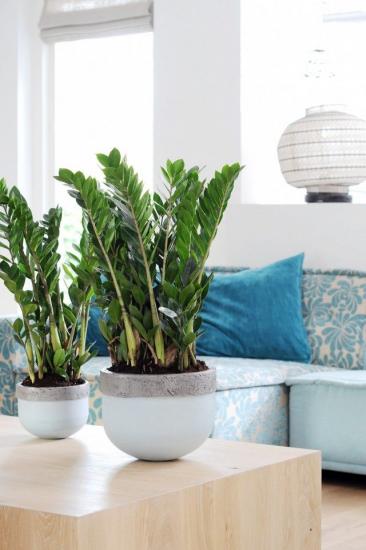

The main requirement that this flower makes to the soil is good air permeability.
The most suitable is a combination of sod soil and sand with the addition of small pebbles or expanded clay. This mixture will provide the rhizome with the maximum amount of oxygen for normal growth and development.
Thus, it is not recommended to use loamy soils with a high level of humus for planting a dollar tree. Such a mixture can lead to root decay - due to its property of retaining water for a long time.
If not purchased, but self-prepared soil is used, it is recommended to thoroughly disinfect the mixture before direct planting. This can be done by pouring boiling water over the substrate, or by placing it in the oven for a while.
How to plant a flower?
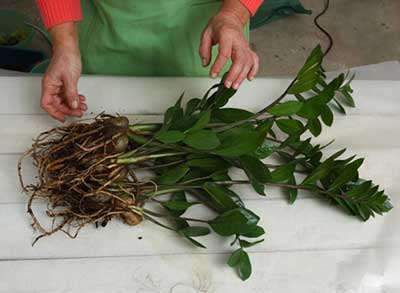

Zamioculcas can be propagated using feathers or leaves.
It often happens that a leaf that has fallen on its own already has a formed tuber - and this is real luck.
It remains only to plant it in the soil and wait for the formation of the root system. The process does not depend on the person in any way and, in fact, does not require anything.
If there is no fallen leaf with a tuber, then separate it from the bush, dry it a little (4 days), and then plant it in sandy soil. The process will speed up if you choose the largest sheet possible. It will be easy to take care of him, the main thing is watering.
Description
The plant has a thick tuberous rhizome for storing water and using it when there is a lack of moisture. The leaves are swollen at the base, they are pinnate, erect, can reach 1 m in length. Their surface is covered with a wax coating to protect against moisture evaporation. With a lack of it, the flower sheds its leaves, although it is considered an evergreen plant.
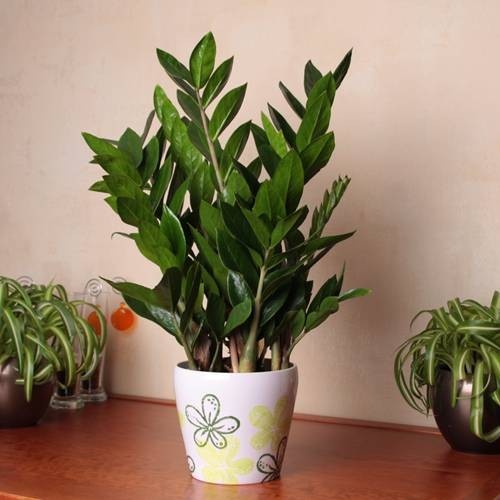

The inflorescence of the plant is not particularly attractive. True, it is difficult to see this phenomenon, since zamiokulkas rarely blooms at home. The inflorescence is presented in the form of a cob on a thick peduncle, on which there are light, small flowers.
The plant easily tolerates low air humidity and darkening. But nevertheless, a bright place without direct rays of the sun is more suitable for him. During transplantation, watering and other procedures with the plant, gloves are required. Since the sap of the plant is poisonous, do not allow it to come into contact with the skin.
Preparation of the necessary materials for transfer to a new pot
How to transplant zamioculcas? The first step is to choose the correct container for the plant. It is advisable not to use narrow and elongated ones. Better if it is a plastic or clay container, wide enough and roomy. Ideally, the pot should not be too bulky, but at the same time not cramped. And remember, it is extremely important that there are holes in the bottom of the container for excess liquid to drain. After purchasing a pot, you need to take care of special drainage. Expanded clay is sold in any florist shops. It is advisable to purchase a medium-sized drainage (fractions 10-20 mm in diameter). You will also need a high-quality substrate: it must be moisture-permeable, slightly acidic and nutritious. It is desirable that the soil mixture consisted of turf, leaf, peat soil and sand in equal proportions. It is also recommended to add some charcoal to the substrate. If you cannot make up the soil mixture on your own - get a ready-made one. After all the "ingredients" are ready, you can start handling the flower.
The size
When choosing a pot for zamiocalcus, you need to be guided by several rules.
- When transplanting, the capacity should be slightly larger than the previous pot was. If the flower is transplanted into a pot that is too large, then the result will be no growth of the ground part until the root system grows over the entire pot.
- A deep pot is also not worth choosing, since it can hold more soil than the plant needs. In addition, more water is required in order to shed the soil, which can cause waterlogging of the root system and its decay.
- Consider the size of the plant. If the zamiocalcus has massive trunks that grow densely, it is better to purchase a wider pot.Adult plants have a well-developed root system, and tubers are usually large in size. Young plants have thin shoots with small tubers and a poorly developed rhizome. For such a flower, it is better to choose a flowerpot 1–2 cm wider than the diameter of the previous container.
- Choose a pot so that, in addition to the root system and soil, expanded clay will fit in it; the container should not be too low and wide.
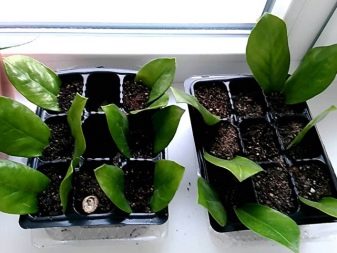

Evergreen zamioculcas: care and growing secrets
The flower zamioculcas, the care of which differs in some features, is poisonous. Do not forget that there are plenty of poisonous indoor plants, so you need to be careful. Once you've brought it home, there is no need to rush and change the pot. Ceramic containers are not suitable for this flower, since the roots are easily damaged, and new plastic ones are not suitable for all. It is best to leave temporary store, change only the soil.
It is not recommended to use solid flowerpots, the plastic can be cut if necessary, but the ceramics can only be replaced. The soil should contain a lot of mineral and organic substances and have excellent drainage.
How to transplant correctly?
Zamioculcas
Zamioculcas, which is not so difficult to transplant at home, still requires one important condition: this plant is poisonous, it is imperative to use protective gloves! Keep children and pets away from the pot, it is best to place it on a raised elevation where it will be inaccessible.
Zamioculcas, the transplantation of which begins in the spring, is planted in a pot with a good drainage layer of expanded clay. Suitable material of an average fraction of up to twenty millimeters. After that, sand is poured up to one quarter of the volume.
The transshipment should be done annually, for young plants they take a flowerpot slightly larger than the old one. You do not need to touch the earthy ball, the roots are not shaken off. If possible, it is not recommended to touch old plants.
Basic tips for growing
Such a bright and unusual flower Zamiokulkas, the care of which is not much different from other unpretentious home flowers, loves care.
Here are some tips to help you grow a healthy and beautiful plant:
- in winter, it is best to put a flower near a window, where it will receive the required amount of light and heat, but after wintering, it is necessary to start accustoming it to summer conditions gradually, otherwise the leaves will receive severe burns from sunlight. And the temperature needs to be raised a little;
- it is better to let the soil be a little overdried, excess moisture will lead to rotting of the tuber and roots. In summer, the zamioculcas flower, for which more careful care is already required, prefers frequent watering, it is not necessary to spray the leaves;
- if possible, then it is necessary to expose the zamiokulkas to the open air, for example, a balcony. In this case, the leaves will need to be wiped from dust, sprayed a little;
- top dressing is suitable for both cacti and succulents, it is advisable to fertilize from April to August. Such compositions are introduced into the soil once every two weeks;
- if the zamiokulkas stood on the balcony in cloudy, rainy weather, it is no longer necessary to water it, but it is also impossible to allow the pot to flood. Therefore, do not leave your pet unattended;
- you can use special supports so that the crown does not outweigh the fleshy stem.
Reproduction at home
The zamioculcas flower reproduces at home rather hard, although this is possible. Three different methods are used: with a leaf, dividing a bush and cuttings. In this case, the part of the plant that will be selected for transplanting should be as large as possible, then the probability of rooting is greater.
Leaf blades must be planted in a special mixture of peat and sand, approximately one to one. It is better to root in a warm room, the lighting should be diffused.Cover the pots with a piece of glass.
It is in such conditions that a tuberous organ begins to form, on the surface of which the roots and buds of the future zamioculcas will develop. To increase the thermal effect, you can put a jar of water on top of the glass.
The rest of the methods at home are difficult, experts do not recommend using them without special training and experience.
Care at different times of the year
At different times of the year, zamioculcas flowers require specific care. So, starting in late autumn and during the winter months, the plant becomes dormant. At this time, it needs especially careful care, it needs to be watered less often, kept at a lower temperature than in hot summer.
Zamiokulkas tubers
He needs a little more light at this time, the pot can be safely put in a well-lit place. The ambient temperature should be from plus sixteen to plus eighteen degrees. Between watering, the earthen lump should almost completely dry out, the plant will have enough of the moisture reserves that it made in the summer.
Starting in spring, the air temperature is gradually raised, and watering should become more frequent. Top dressing is done once every two weeks. The light should now be diffused, the ambient temperature can reach twenty-nine degrees, its lowest point is twenty - twenty-two degrees.
In summer, it is important not to overflow, as the root system can very easily rot. Spraying is not required for the most part, the flower is accustomed to dry air.
Among exotic plants, zamioculcas, the care of which is not so difficult, is one of the most unpretentious. Its tuber perfectly stores moisture, it does not need spraying, and care is minimal in winter. But you should not abandon your pet, because he also loves attention and care.
Similar articles
We transplant zamiokulkas
Hello my dear friends. Our houseplants are waiting for us again, so let's give them their due attention again.
Last time we talked in general terms about a wonderful native of Africa - zamioculcas, which, despite its roots (in terms of origin, I mean), is rather unpretentious and at the same time stunningly beautiful. Many more people have dubbed this plant a dollar tree, although the people affectionately call it a hitch, so as not to twist the tongue every time, pronouncing the name of the plant in its entirety.
In any case, no matter how the flower growers call it, almost all of them without exception believe in the plant's ability to increase the well-being of its owner - that's why zamiokulkas so often lives in representative offices of reputable companies.
But still, its main advantage is its amazing unpretentiousness, despite the fears of many flower lovers, who are accustomed to the fact that the more beautiful the plant, the more capricious and demanding it is. In this case, everything is exactly the opposite: it doesn't matter if you forget to water or put it closer to the light source.
Zamiokulkas transplant
But today, as I promised in the previous article, we will talk about, perhaps, the only pitfall on the way to the happiness of the owners of this wonderful plant in all respects - its transplant.
As I mentioned last time, I was presented with an invaluable gift - an adult zamiokulkas. The only "but" was the need - and an urgent one - for a transplant, since the previous owner did not check the bottom of the pot into which the plant had been transferred before, and there were no drainage holes in it. But the main enemy of zamiokulkas, oddly enough, is precisely water. Its roots rot at times - that is why I will again remind you of the main rule of caring for this succulent: it is better to underfill than to pour!
So, let's briefly go over the main features of plant transplantation and proceed to the practical part.
It is best to transplant zamiokulkas into light soil, it must be able to easily pass both air and water. Ideally, it is better to season the soil with expanded clay - this way you loosen the soil enough to make the plant feel quite comfortable. The bottom of the pot should be covered with a layer of foam or any other drainage material, the volume of which should not exceed twenty-five percent of the total volume of the pot. Be sure to make holes in it to drain excess moisture!
The main thing to remember is that the zamioculcas is rolled over, not transplanted. What is the trick here? Nature generously endowed zamiokulkas with a rather extensive root system - so it is better not to injure it during the transplantation process, otherwise the consequences can be dire. Moreover, for this process, the spring season is best suited - March is ideal, but only if dry and sunny weather has already established itself. But, in general, with careful handling of the correct approach to the transplant process, you should not be afraid to once again transplant your zamiokulkas, if he really needs it - as in my particular case.
If, for some reason, you cannot do without removing the previous earthen coma, you should not worry about the further well-being of your green pet - it can easily withstand rinsing the roots under warm water. It is important to take into account that in no case should it be transplanted immediately after such a washing! Be sure to give it some time for the roots to dry out! And in this case, plant the plant exclusively in dry soil, previously enriched with pieces of coal. If the root system was flushed before transplanting, do not try to water it earlier than several weeks after it! Moreover, before the next watering, the earthen who needs to be given the opportunity to dry out completely! This is very important, comrades, do not neglect this recommendation, otherwise you risk losing the hitch in a very short time! Better forget to water, by God!
When transplanting, keep in mind that the tubers of the plant should not be completely covered with soil - you can leave them partially in plain sight. If desired, the maximum that can be done is to cover them with a thin layer of soil.
And now one more nuance about the soil: in many sources you will see recommendations for using the most nutritious soil for planting a hitch - with this I completely agree. And then we read: for planting zamiokulkas, a mixture of sand, peat, turf and leafy soil should be used, which can be additionally enriched with humus. Sounds good, doesn't it? But only more experienced flower growers repeatedly advised me to refrain from adding peat for the same banal reason - zamioculcas is not friendly with moisture, and peat tends to retain it. Hence the conclusion: do not tempt the fate of your plant! It is better to refrain from such additives than to bite your elbows later, mourning the deceased pet!
If, for example, you have just acquired a zamioculcas and want to transplant it urgently and faintly, take your time - we do not catch fleas, and the plant needs those notorious several weeks - at least two or three - for adaptation. It is not necessary to aggravate the stress experienced by the plant in connection with moving to a new place of residence - it is now and so oh how difficult it is, although he is a tough nut to crack.
We turn to the last point of the theoretical part - the choice of a pot for transplanting. Here you should be guided by the rule of the golden mean: no pots for growth, but you should not save space either. The pot should be of exactly the same volume in which the root system of the zamiokulkas is freely located. As you can see, I followed the recommendations of the floriculture guru, preparing a plastic pot - not too tall, but quite wide - it is in such a container that the plant will be comfortable.Why is it not worth providing a reserve of space to the zamik? It's simple: the growth of zamiokulkas leaves begins only when the root system fills the entire volume of the pot offered to it. So think, do you need a bald hitch with developed roots, or do you still advocate for its decorative effect? I think the answer is obvious.
Another little trick: you shouldn't spend money on expensive ceramic pots, and it's not about saving at all. Just when transplanting, which the plant needs every three years, it will be easier for you to free the root system of the lock intact by simply cutting the plastic container. So choose a plastic pot and preferably soft.
The transshipment process is not at all complicated: the plant, along with the earthy clod, moves into a new planting container, after which you should add some fresh soil, filling the pot to the brim.
My transplanted handsome in the picture above!
By the way, in the process of transplanting, accidentally broken off leaves may appear - use them to propagate the plant. Moreover, both twigs covered with leaf plates and individual leaves are suitable - the success of our event does not depend on this.
Then everything is elementary: stick your seedlings into the peat - this is where it will come in handy for us - and that's it. Do not touch them for a month and a half or two. And when I say don't touch, I mean exactly the absence of any kind of care, checks for rooting, etc., and so on. The only acceptable care is periodic spraying of the seedlings. Note: not watering, but spraying with an ordinary spray bottle. Otherwise, the seedlings will rot.
There is no need to additionally cover or highlight your flowers. Just let them take root. Believe me, it will definitely happen.
As you can see, I am again proving my avidity for experiments. I put one leaf in water, the second stuck in a pot of dracaena: it is very risky, because dracaena the dragon loves abundant watering, but the drainage in the pot is excellent, so let's see what happens. And the third was rooted in peat soil. I will report the results as soon as my experimental plantings will give (or, God forbid, will not give) nodules.
On this, perhaps, everything. Transplant zamiokulkasy and return to our pages for new discoveries.
PS: it is not always with unplanned picnics that kefir is at hand to marinate the meat and give it the proper softness. Do not rush to get upset - an ordinary mineral water will cope with this task just as well.
How to do it correctly Step-by-step description of the procedure
Important: all work with the plant should be carried out exclusively with gloves, as its juice is poisonous. How to transplant zamiokulkas: first, take a prepared pot and fill it 1/4 with expanded clay. Pour a layer of sand on top. Then, carefully, so as not to damage the tuber and roots, we take out the plant from the old pot. A young specimen does not need to remove the earthy clod in which it grew. Then we transfer the plant to a new pot, after which we add a new soil mixture there. In this case, do not deepen the roots of the plant too much. That's all, now you know how to transplant zamioculcas. The photo shows the process of transferring a young, recently purchased plant into a new pot. After the procedure, the earthen lump is moistened, and the plant is placed on a well-lit windowsill.
When and how often a plant can be replanted
If you transplant zamioculcas annually, then there will be no harm from this. Plus, you can easily spot pests or root problems. Some growers recommend replanting this indoor flower every 2-3 years.
You can transplant zamiokulkas at any time of the year, but it is best to transplant in late autumn.In summer, this can cause unnecessary stress on the plant, which is in the phase of active vegetation and reproduction. Early spring is also good for transplanting.
Did you know? The people call this plant "dollar tree". It is believed that the appearance of each new leaf heralds the owner of a sudden monetary profit.
Growing problems
Due to improper fit, some difficulties may appear:
- Loss of leaf turgor. Yellowed and flabby leaves appear from over-watering. The flower's turgor is lost due to decay of the root system. At the first symptoms of deterioration, it is necessary to reduce watering. If the situation does not improve, plant transplantation into dry soil is required. Another reason is the wrong pot. The flower does not need to be immediately planted in a large container. The soil, not reclaimed by the roots, quickly sours and will be a breeding ground for rot.
- The need to transplant into another soil. When the soil does not allow air to pass through well and retains moisture, the flower dies. Therefore, if the substrate has become denser, it is necessary to transplant the plant into light soil.
